
Introduction
Over the last couple of months we've taken an in
depth look at Dell's latest updates to their 24" and 27" UltraSharp monitor
range. Dell have decided to replace the old 24" U2410 with the
U2413 and also
replace the 27" U2711 with the
U2713H. These marked the move to a new type of
backlighting system, the addition of a few nice new features, but the retention
of some of the aspects which made the old screens so popular. We concluded in
both cases that the new models were worthy replacements for the old models. Now
we have Dell's latest 30" model with us, the U3014. This is designed to replace
the
U3011 as well, and follows a similar update path as the smaller models. You
may note that the 24" and 27" models had the 2013 model names (U2413 / U2713H)
since they were released towards the end of 2012, and because Dell like to
pre-empt the new year with the new model numbers. The 30" model has been
released a little later in the early part of 2013 and so instead carries the
2014 model name. We will carry out our usual tests on the new screen as well as
make a direct comparison with the U3011 it is replacing.
Dell's website says "Create
precision work with the high-performance 30" Dell UltraSharp U3014 monitor
offering wide-ranging flexibility, efficiency and factory
calibration...Designers, CGI animators, engineers, programmers, photographers
and power users across many industries can benefit from high-end capabilities
offered by the Dell UltraSharp U3014."


Specifications and Features
The following table gives detailed information
about the specs of the screen:
|
Monitor
Specifications |
|
Size |
30"WS (75.6 cm) |
Panel Coating |
Light
Anti-glare (matte) |
|
Aspect Ratio |
16:10 |
Interfaces |
1x Dual-link DVI (HDCP), 1x DisplayPort 1.2,
1x Mini DisplayPort 1.2, 1x HDMI |
|
Resolution |
2560 x 1600 |
|
Pixel Pitch |
0.252 mm |
Design
colour |
Matte black bezel and stand |
|
Response Time |
6ms G2G |
Ergonomics |
Tilt,
swivel, 90mm height |
|
Static Contrast Ratio |
1000:1 |
|
Dynamic Contrast Ratio |
2 million:1 |
VESA Compatible |
Yes 100mm |
|
Brightness |
50 to 350 |
Accessories |
DL-DVI cable, Power cord, USB 3.0 upstream cable, Mini DP to DisplayPort cable,
Cable Tie, Factory Calibration Report |
|
Viewing Angles |
178/178 |
|
Panel Technology |
AH-IPS |
Weight |
With stand and cables:
10.84Kg |
|
Backlight Technology |
GB-LED |
Physical Dimensions |
(WxHxD with stand - max height)
689.7 x 572.7 x 201.4 mm |
|
Colour Depth |
1.07 billion (10-bit) |
|
Refresh Rate |
60Hz |
Special
Features |
4x
USB 3.0 ports, Audio out, Factory calibration (sRGB and Adobe RGB modes),
hardware 14-bit LUT
calibration, uniformity correction, touch sensitive controls, 9-in-1 card
reader, PiP and PbP |
|
Colour Gamut |
Wide Gamut
103% NTSC (CIE 1931), 99% Adobe RGB, 100% sRGB coverage |
Manufacturers website link:
Dell
The U3014 basically offers the exact same feature
set as the smaller U2413 and U2713H models. It has a very good range of video
connections which is great to see and something which Dell have always done a
good job with on their UltraSharp models. There are HDMI, Dual-link DVI-D,
DisplayPort and now Mini DisplayPort provided for video interfaces. The D-sub
connection which was available on the older U3011 has now
been left off, presumably because it's less commonly used nowadays and can't
support the full native 2560 x 1600 resolution anyway. It's nice to see HDMI provided for
users who want to connect other devices, particularly external Blu-ray and DVD
players. The digital interfaces are HDCP certified for encrypted content as
well. There is also an audio out connection for connecting headphones / external
speakers if you wish to take the sound from the HDMI or DisplayPort inputs.
There are no integrated stereo speakers on this model although the screen is
compatible with Dell's SoundBar if you wish.
The screen comes packaged with a dual-link DVI and
DisplayPort > Mini DisplayPort cables which is useful although there is no
normal DisplayPort or HDMI cable provided with the screen unfortunately,
presumably due to cost saving measures. The screen has an internal power supply
and so you only need a standard kettle lead (provided) to power the screen.
There is a 4-port USB 3.0 hub provided as well, with 2 ports on the back and 2
ports on the left hand side of the screen. The USB cable to connect back to your
PC to power these ports is provided in the box. Like the older U3011 model there
is a card reader on this model (9-in-1) which personally I find useful. A nice
extra.
The
screen features a programmable 14-bit LUT to allow for hardware level
calibration via the appropriate software/hardware (see
hardware calibration section later on for details). The screen also has a
uniformity correction technology which we will
test later on
as well.
Below is a summary of the features and connections
of the screen:
|
Feature |
Yes / No |
Feature |
Yes / No |
|
Tilt adjust |
 |
DVI |
 |
|
Height adjust |
 |
HDMI |
 |
|
Swivel adjust |
 |
D-sub |
 |
|
Rotate adjust |
 |
DisplayPort |
 |
|
VESA compliant |
 |
Component |
 |
|
USB Ports |
 |
Composite |
 |
|
Card Reader |
 |
Audio connection |
 |
|
Ambient Light Sensor |
 |
HDCP Support |
 |
|
Touch Screen |
 |
MHL Support |
 |
|
Hardware calibration |
 |
Integrated Speakers |
 |
|
Uniformity correction |
 |
PiP / PbP |
 |
The U3014 looks pretty much identical to the
U2713H and U2413 models, but obviously in a larger size. It comes in an all-black coloured
design with matte plastics used for the bezel and stand. The bezel is a thin
and attractive at ~22mm wide along all sides. It is a slightly different finish
to the old U3011 and looks almost like a brushed black aluminium in style, but
is still plastic.
The lower bezel features a shiny silver coloured
Dell logo in the centre as you can see from the above images. There is no
other writing on the bezel at all. The edges of the screen are a little
rounded, more so than the rather straight lined U3011 in fact. I personally
like the design and it looks very nice on the desk. The screen is noticeably
bigger vertically than the 27" models we have become quite used to testing.
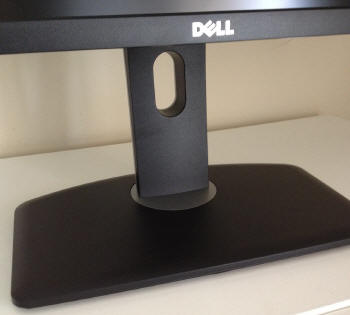
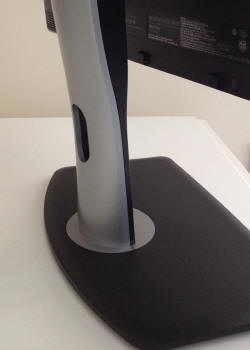
Above: views of the base and stand. Click for larger versions
The base of the stand is fairly large,
measuring 315mm across and is
made from a matte black plastic. It provide a decent balance for the
screen and it remains sturdy when positioned on the desk.

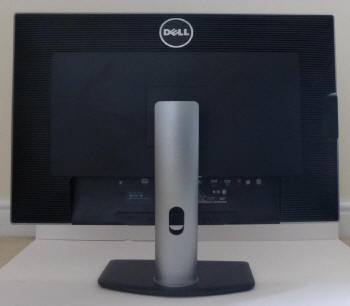
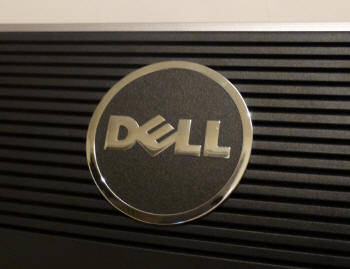
Above: views of the back of the screen. Click for larger versions
The back of the screen is again a matte black
plastic and is nicely rounded and enclosed well. There is a round Dell logo at
the top as shown above. The interface connections are located in the lower
portion. While the front of the monitor
arm / stand is a matte black colour, the back of the stand is a silver
coloured plastic which looks nice and provides a good contrast to the black
plastics elsewhere.

The stand comes packages disconnected from the
screen in the box. It is incredibly easy to connection and you simply slot it
into the panel and it clips in to place. You are able to VESA 100mm wall-mount
the screen if you wish as well, and thanks to its thin profile and relatively light
weight (7.35 Kg without the stand) compared with its predecessor (U3011 = 9.3 Kg without stand), it is perhaps
a more suitable screen for that option.
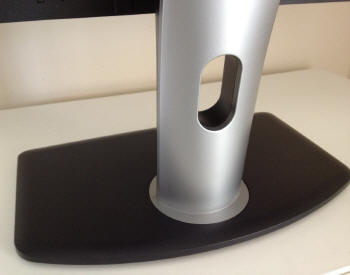
Above: view of the base and stand and cable tidy hole. Click for larger
version
There is a useful cable tidy hole as you can see
from the images above. The screen is also provided with a small Velcro cable
tidy clip to help keep everything neat.

Above: OSD operational buttons
The OSD operational buttons and power on/off are
located in the bottom right hand corner and are situated on the front of the
screen as shown, along the right hand side. The power is an actual pressable buttons
but the rest are touch sensitive as they were on the U3011. These only light
up when you use them and so are very well hidden during normal use. When the screen is turned on the power LED glows a subtle
white colour, and it pulsates on and off in the same white colour when the
screen is in
standby.

Above: side view of the screen showing profile
The screen has a fairly thin profile from
the side thanks to the use of a GB-LED backlighting unit. It measures only
201.4 mm deep with the stand, just 0.9mm thicker than the U2413 and U2713H
in fact.

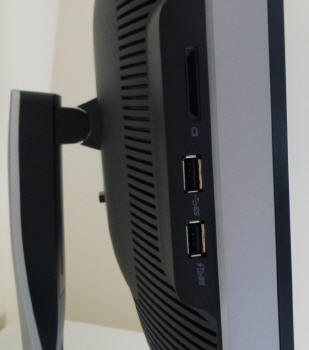

Above: Side view showing 2x USB 3.0 ports and card reader
The screen offers 2x USB 3.0 ports on the
left hand edge of the screen as shown above, for easy access and
connection of peripherals. There are a further 2 ports on the back of the
screen too. Above these ports on the left hand side is the integrated
9-in-1 card reader which supports the following formats:


The U3014 comes with a decent range of
ergonomic adjustments from the stand which is good news and something
we've come to expect from Dell's UltraSharp range.
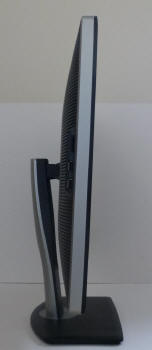
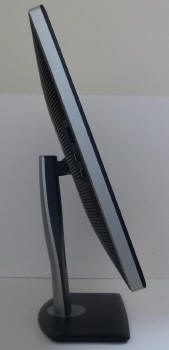
Above: side views showing full range of tilt adjustment. Click for larger
versions
There is wide tilt range, allowing you to
move the screen forward 4° and back by 21°. This affords you a good range
for a wide variation of angles. The movement is pretty easy and nice and smooth.
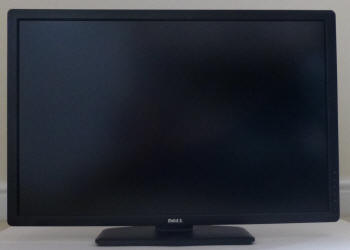
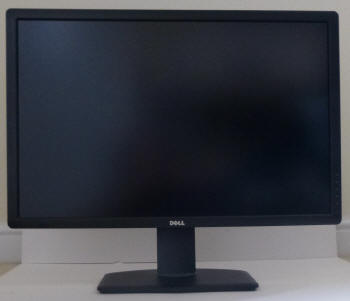
Above: front views showing full range of height adjustment. Click for
larger versions
The height adjustment range is pretty good as
well. At the
lowest setting the bottom of the lower bezel is approximately 30mm from the
desk so you can get a nice low height if you require. At its highest setting
the bottom of the bezel sits 120mm from the desk giving you a total adjustment
range of 90mm. The movement is again easy and smooth.
The
swivel adjustment is smooth and easy as well, and the screen stays firm on the
desk while the stand swivels from side to side. There is no rotate function
from this model as it would be impractical anyway with a screen this big
surely. There is no real wobble from the screen while it's sat on the
desk which is good.
A summary of the screens ergonomic adjustments
is shown below:
|
Function |
Range |
Smoothness |
Ease of Use |
|
Tilt |
-21°
to +4° |
Smooth |
Easy |
|
Height |
90mm |
Smooth |
Easy |
|
Swivel |
45°
+/- |
Smooth |
Easy |
|
Rotate |
n/a |
- |
- |
|
Overall |
Good range of adjustments and easy to
use. Sturdy design and feel. |
The screen materials are of a good quality and
the design is attractive in my opinion. There is a no audible noise from the
screen during normal use even if you listen closely. The screen is also free from a buzzing issue
which some users noticed on the 27" U2713HM and U2713H models in certain circumstances.
This was mostly when viewing a single large text document or spreadsheet full
screen, but thankfully that doesn't appear to be a problem here.
The
screen stays pretty cool during use although there is a little heat given off
at the back near the top.


Above: interface connections on back of the screen. Click for larger
version
The back of the screen features video interface
connections for DL-DVI, HDMI, DisplayPort and Mini-DisplayPort. There is also
a DisplayPort out connection used for Daisy Chaining several displays as shown
below. The digital connections
are HDCP certified. There is also a standard kettle lead power connection as
the screen has an integrated power supply. This does make it a little thicker
than some of the ultra-thin profile screens you can find which offer an
external power brick. There is a single connection for Dell's sound bar if you
want to add some speakers to the screen and there's an audio-out socket if
you'd rather connect headphones or an external speaker system to listen to the
sound from the HDMI and DisplayPort connections. There is also 1x USB upstream
for connecting to your PC (cable provided) and 2x USB 3.0 downstream ports
available for connecting external devices. Note these are the new generation
USB 3.0 ports providing faster transfer rates for compatible devices.
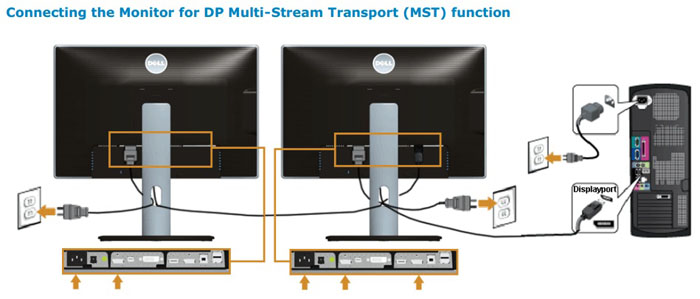
Note: some of the above images courtesy of
Dell

OSD Menu

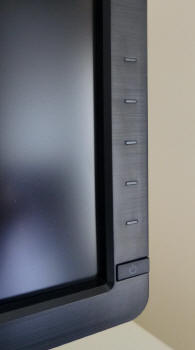
Above: views of
OSD operational buttons
The control of the screen and the OSD menu are
practically identical to the U2413 and U2713H as you might expect. Like the
U3011, the Dell U3014 has
touch-sensitive
OSD buttons. These 5 buttons are located on
the right hand side of the screen next to a pressable power button. The
sensitivity works well in practice. Hovering your finger over any of them lights
up the bottom button. If you then press that bottom button it brings up the 5
options available from the 5 touch sensitive buttons as shown below. All the
buttons then light up in a white colour to show they are now available to use.
The power LED glows white by the way during normal use, and pulses on / off
white when the screen is in standby.

When you first press the bottom button it pops up
a quick launch menu. From here there is quick access to preset mode
selection, brightness / contrast controls and the input source. You can also select to
enter into the main menu, or simply exit the quick launch menu. You can in fact
personalise the three quick launch options from within the main menu should you
wish to.
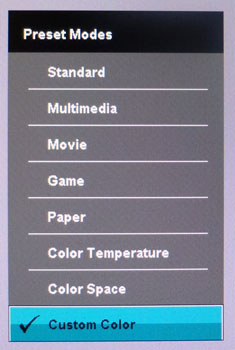
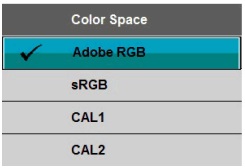
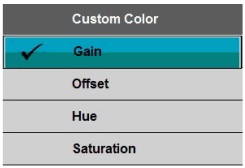
Within the preset modes menu there are options for
standard, multimedia, movie, game, paper, colour temperature, color spaces and custom colour.
The paper preset is new and replaces the 'text' mode which used to feature
instead on Dell monitors like this. The color space mode is also a new one,
giving you access to the sRGB and Adobe RGB emulation modes as well as 2 user
calibrated modes if you
hardware calibrate the screen (above left). The sRGB and Adobe RGB modes here also carry the factory calibration which we will
test later on.
If you enter the 'custom color' mode you have access to adjustments for gain,
offset, hue and saturation (above right), giving the user a great control over
the hardware.
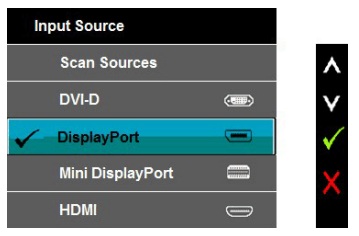
The input source quick launch gives you access to
the video inputs as above.
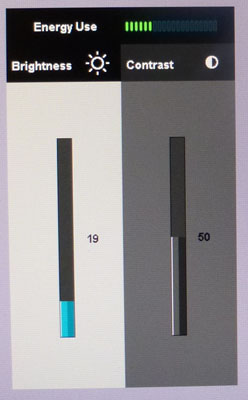
The brightness/contrast quick launch gives you
access to those controls as shown above. We won't bother changing the OSD screen
shots below to the U3014 versions as the menu is identical to the U2413.
Obviously it would say "Dell U3014" in the top left hand corner and confirm you
are running at the native 2560 x 1600 resolution in the bottom left hand corner.
The rest remains unchanged.
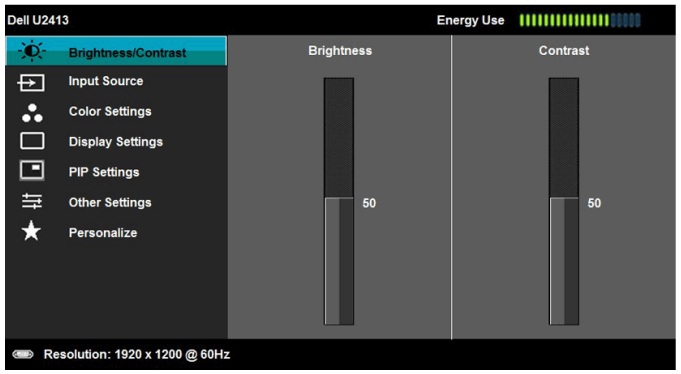
Bringing up the main menu presents you with
various sub-sections down the left hand side as shown. At the top right there is the now familiar "energy
use" bar which gives you a visual indication of the power consumption at any
given time. This is based on the OSD brightness setting which controls the
backlight intensity, and therefore has a direct correlation to the power
consumption. The brightness/contrast section is self explanatory of course and
is shown above.
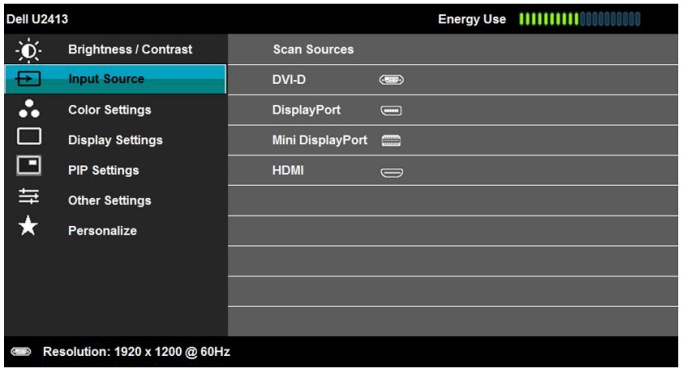
The input source section allows you to manually
select which interface is in use.
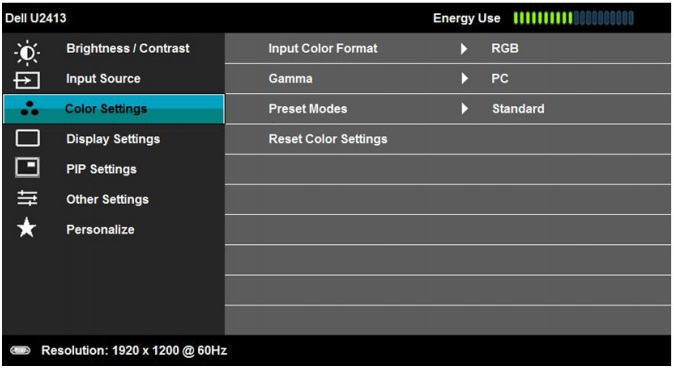
Colour settings allows you to change a couple of
settings relating to colour format and gamma, but perhaps more useful here is
access to the preset colour modes.
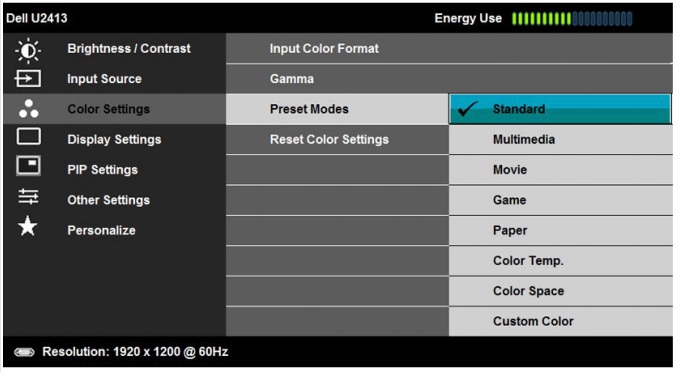
The preset modes listed here are the same as those
accessed via the quick launch menu.
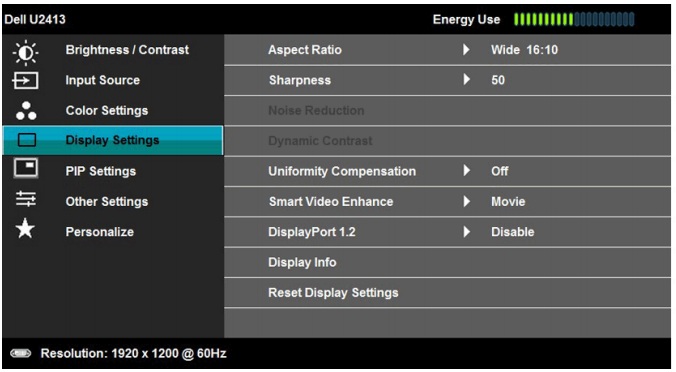
The display settings section allows you to change
the monitors aspect ratio for external devices and games. There are options for
wide 16:10, 16:9, auto resize, 4:3 and 1:1 here. You can also turn the
dynamic contrast ratio
control on and off in this section of the menu, if you are in a suitable preset
mode where it can be activated. Of other note is the new 'Uniformity
Compensation' option which we will
test later on
as well. There is also a new 'Smart Video
Enhance' feature and an option to set up the DisplayPort daisy chaining.
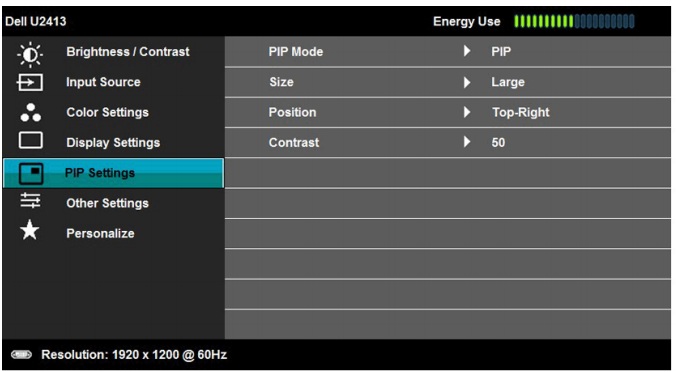
The PiP settings section allows you to control
various options related to Picture In Picture (PiP) and Picture By Picture
(PbP). The following configurations are available according to the manual.
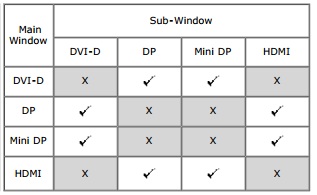
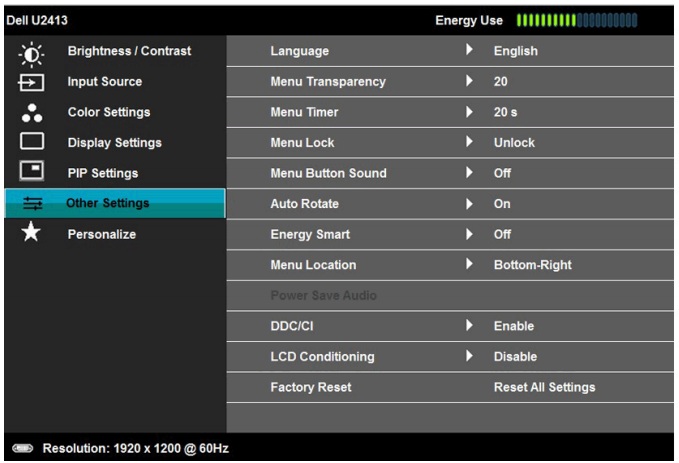
The other settings section has some controls over
the OSD itself. The 'Energy Smart' feature can be turned on and off here as
well.
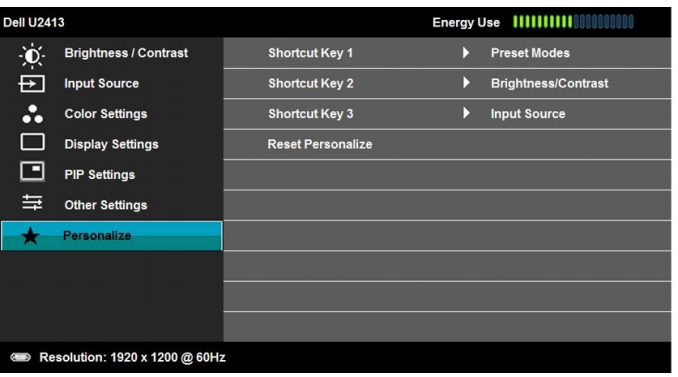
The personalize section allows you to change the
quick launch keys if you wish. You can change them to activate preset modes,
brightness/contrast, input source, aspect ratio and PiP mode if you wish.
Overall the OSD menu offers a decent range of
options and it is intuitive and well structured. The touch sensitive buttons
worked well on the most part although we did find it a little tricky to click
and hold a button sometimes (e.g. when scrolling rapidly between brightness
settings). Sometimes they didn't respond as hoped but on the whole they were
useable.

Power Consumption
In terms of power consumption the manufacturers spec states
typical
usage of 60W and 130W maximum (with luminance max, USB connected and SoundBar
connected). In standby the screen apparently uses <0.5W.
|
 |
|
State and Brightness
Setting |
Manufacturer Spec (W) |
Measured Power Usage
(W) |
|
Factory Default (50%) |
60.0 |
59.7 |
|
Calibrated (23%) |
- |
44.0 |
|
Maximum Brightness (100%) |
120.0 |
76.4 |
|
Minimum Brightness (0%) |
- |
30.5 |
|
Standby |
<0.5 |
1.2 |
|
We tested this ourselves and found that out of the
box the screen used 59.7W of power while at its default brightness setting. At
the maximum brightness level the screen used 76.4W of
power, and at the lowest setting this was measured at 30.5W. Once calibrated we
had reached a power consumption of 44.0W which had been once the screen had been
set to achieve a luminance of 120
cd/m2 (custom
color mode). During
standby the screen uses 1.2W of power.
We have plotted the results of these measurements
on the graph below:


Panel and Backlighting
|
Panel Manufacturer |
LG.Display |
Colour Palette |
1.07 billion |
|
Panel Technology |
AH-IPS |
Colour Depth |
10-bit |
|
Panel Module |
LM300WQ6-SLA1 |
Colour space |
Wide Gamut |
|
Backlighting Type |
GB-LED |
Colour space coverage (%) |
103% NTSC, 99% Adobe RGB, 100% sRGB coverage |


Panel and Colour Depth
The Dell U3014 utilises an
LG.Display LM300WQ6-SLA1 AH-IPS panel which is capable of producing 1.07
billion colours. According to the detailed panel spec sheet this is done with a
10-bit colour depth and there is no mention of
Frame Rate Control (FRC) being used. Dell refer to the panel as
being "AH-IPS" (Advanced High Performance IPS) in some of their marketing
material, and it is a name which is starting to become more common in today's
IPS market. We have started to see other screens emerge with these so-called
AH-IPS panels in their specs, and indeed LG.Display themselves made the same
distinction when discussing their forthcoming panels (including this one)
last
year. This new Q6 panel actually does represent a new
generation of IPS in so much as it features a new type of backlighting which we
will discuss in a moment.
The panel is confirmed when dismantling the screen
as shown below.
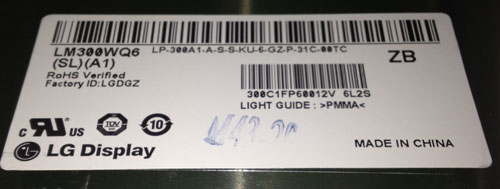
Above: view of
the panel used from dismantled screen.
Like the U3011 which it is replacing, the new
U3014 offers support for 10-bit content. This gives a colour depth support for 1.07 billion colours. However,
you need to take into account whether this is practically useable and whether
you're ever going to truly use that colour depth. You need to have a full
10-bit end to end workflow to take advantage of it which is still quite
expensive to achieve and rare in the market, certainly for your average user.
This includes relevant applications and graphics cards as well, so to many
people this 10-bit support might be irrelevant. Given the U3014's position as a
professional grade, high-end screen, it's pleasing to see the support included.
Panel Coating
The
screen coating on the U3014 is much like that featured on other recent Dell
IPS screens like the U2413, U2713H and U2713HM, all of which
has been a positive change. It is a normal anti-glare (AG) offering
as opposed to any kind of glossy coating. However, this is contrary to a lot of
other older IPS based screens which usually feature a grainy and aggressive
solution. In fact the Dell U3011 featured such a coating and was often
criticized for its grainy, dirty appearance, especially on light coloured
backgrounds. When Dell released the 27" U2713HM users were impressed by the new
lighter AG coating which is an almost semi-glossy type coating. This has been
retained on the new U series screens as well thankfully. Dell seem to have toned down the
AG coating on recent models which is great news. It retains its anti-glare
properties to avoid unwanted reflections, but does not produce an overly grainy
or dirty image that some AG coatings can.
As a side note, some users reported a "cross
hatching" appearance on the 27" U2713HM screen, where on very close
inspection you could detect a small grid like effect as part of the coating.
This didn't affect everyone of course but it was something some people
complained about or became sensitive to. Having seen this so-called cross
hatching on the U2713HM we're pleased to report that none of these new U series
screens
suffer from this and do not show any sign of it, even when looking very closely for it.
Backlighting and Colour Gamut
Like the other new models the U3014 uses a new form of backlighting. The old
U3011 model featured a CCFL backlight unit which
supported a wide colour gamut (WCG-CCFL). In some of the smaller models Dell had
moved since then to use W-LED (White-LED) backlighting which
offers environmental and energy benefits along with a thinner form factor. This
delivered a normal sRGB colour space only, but was more suitable for most
general users. Dell never made this move with their 30" line-up and so there's
been no other models in this size since the U3011. With the new U3014, like the
24" and 27" equivalents, Dell wanted to be able to offer the benefits
of LED backlighting but deliver a wide colour gamut support for colour critical
work and the professional users. With the new LG.Display LM300WQ6-SLA1 panel they
have moved to a new GB-LED backlight system.
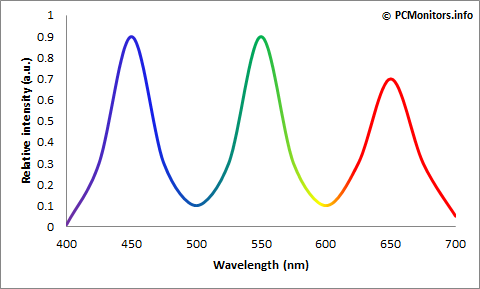
Above: GB-LED
backlight spectrum, courtesy of PCmonitors.info
The common White-LED
backlight systems, despite their name, do not actually use White LED's, but
rather they emit a blue light which passes through a yellow phosphor to give a
more neutral white and provide the red and green components of the image. With
the new GB-LED backlights, rather than using this blue diode + yellow phosphor,
the backlights combine green and blue diodes with a red phosphor (i.e.
Green-Blue LED = GB-LED). PCMonitors.info has a useful article about
The Evolution of LED Backlights which is well worth a read as well. With
this new type of LED backlight the screen
covers 103% of the NTSC reference, 99% of the Adobe RGB reference and 100% (and
beyond) of the sRGB space. The screen is of course classified as a wide gamut
display and the colour space coverage is actually ever so slightly more than the
old U3011 with a WCG-CCFL unit (which has 102% NTSC and 98% Adobe RGB coverage).
We expect to see this type of backlight adopted more widely during 2013.
PWM Flicker Tests at Various
Backlight Brightness Settings - Updated 30 July 13
We tested the screen to establish the methods used
to control backlight dimming. Our in depth article talks in more details about a
common method used for this which is called
Pulse Width Modulation (PWM). Previously we have used a camera based method
as described in the article to capture results at brightness settings of 100, 50
and 0. We now have a more advanced photosensor + oscilloscope system which
will allow us to measure backlight cycling with more accuracy and ultimately
more ease. These tests allow us to establish 1) whether PWM is being used to
control the backlight, 2) the frequency at which this operates if used, and 3)
whether a flicker may be introduced or potentially noticeable at certain
settings. The higher this frequency, the less likely you are to see artefacts
and flicker. The duty cycle (the time for which the backlight is on) is also
important and the shorter the duty cycle, the more potential there is that you
may see flicker. Please remember that not every user would notice a flicker from
the backlight but it is something to be wary of. It is also a hard thing to
quantify as it is very subjective when talking about whether a user may or may
not experience the side effects. We are able to at least measure the frequency
of the backlight using this method and tell you whether the duty cycle is
sufficiently short at certain settings that it may introduce a flicker to those
sensitive to it.
100%
80%
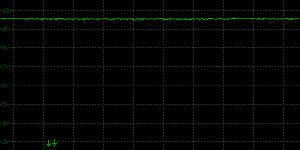
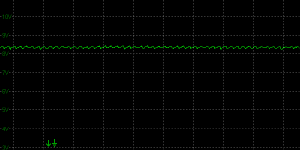
50%
20%
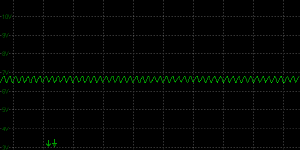
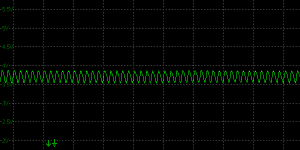
0%
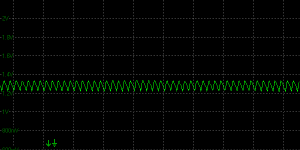
Above scale = 1
horizontal grid = 2ms
At a setting of 100 there was a constant voltage
applied to the backlight as you might expect. However, as you started to lower
the brightness an oscillation with a low amplitude was introduced. This didn't
behave like a "normal" PWM control. At a
setting of 80% the fluctuations in the oscilloscope graph became more obvious
and as you reduced the brightness further they became more pronounced. This
overlapping oscillation was
used to dim the backlight all the way down to 0%. From the tests it was possible
to work out the frequency which was a very high 2500 Hz. This was far higher
than most screens we've seen with PWM (typically 300 - 500Hz). Although it could
be considered that PWM is
being used to some degree, this is likely to be easily high enough that it should cause few
issues with flicker visibly, especially with the low amplitude. If users are
very worried about flicker or particularly
susceptible to it, then you need to be aware of the use of PWM.
|
Pulse Width
Modulation Used |
Yes |
|
Cycling
Frequency |
2500 Hz |
|
Possible
Flicker at |
|
|
100% Brightness |
No |
|
50% Brightness |
Yes |
|
0% Brightness |
Yes |

Testing
Methodology
An
important thing to consider for most users is how a screen will perform out of
the box and with some basic manual adjustments. Since most users won't have
access to hardware colorimeter tools, it is important to understand how the
screen is going to perform in terms of colour accuracy for the average user.
I
restored my graphics card to default settings and disabled any previously active
ICC profiles and gamma corrections. The screen was tested at default factory settings using the DVI interface, and analysed using
an
X-rite i1
Pro Spectrophotometer (not to be confused with the new i1 Display Pro
colorimeter) combined with
LaCie's Blue Eye Pro software suite. An NEC branded and customised X-rite i1 Display 2 colorimeter was
also used to verify the black point and contrast ratio since the i1 Pro is less
reliable at the darker end.
Targets for these tests are as follows:
-
CIE Diagram - validates the colour space
covered by the monitors backlighting in a 2D view, with the black triangle representing the
displays gamut, and other reference colour spaces shown for comparison
-
Gamma - we aim for 2.2 which is the default
for computer monitors
-
Colour temperature / white point - we aim
for 6500k which is the temperature of daylight
-
Luminance - we aim for 120
cd/m2, which is
the recommended luminance for LCD monitors in normal lighting conditions
-
Black depth - we aim
for as low as possible to maximise shadow detail and to offer us the best
contrast ratio
-
Contrast ratio - we aim
for as high as possible. Any dynamic contrast ratio controls are turned off here
if present
-
dE average / maximum -
as low as possible.
If DeltaE >3, the color displayed is significantly different from the
theoretical one, meaning that the difference will be perceptible to the
viewer.
If DeltaE <2, LaCie considers the calibration a success; there remains a
slight difference, but it is barely undetectable.
If DeltaE < 1, the color fidelity is excellent.

Default Performance and
Setup
Default settings of the screen were as follows:
|
Monitor OSD Option |
Default Settings |
|
Brightness |
50% |
|
Contrast |
50% |
|
Preset Mode |
Standard |
|
RGB |
n/a |

Dell U3014 - Default Factory Settings, Standard Mode



|
|
Default Settings
Standard Mode |
|
luminance (cd/m2) |
250 |
|
Black Point (cd/m2) |
0.24 |
|
Contrast Ratio |
1041:1 |
The screen comes out of the box in the 'standard'
preset mode, although there are additional preset modes which carry a
factory calibration
which we will test shortly. Default setup of the screen felt too bright which is
pretty standard for modern screens but can be easily controlled of course via
the brightness control. You could immediately spot the use of the wide gamut
GB-LED backlight as well, with colours looking more saturated and vivid than a
normal standard gamut screen. Reds and greens in particular looked more vivid
and more exaggerated. This is common for wide gamut screens of course. Some
people actually prefer the more saturated colours for things like gaming and
movies, even if it's at the cost of accuracy. We will look at the sRGB emulation
mode
in a moment which is also provided to avoid complications outside of colour
managed applications for those wanting to work specifically in the sRGB colour
space like on a standard gamut screen.
Out of the box the performance of the screen was
pretty reasonable in this standard mode, and we were hopeful of even better performance from
the
factory calibrated modes. The
CIE diagram on the left of the image confirms that the monitors colour gamut (black
triangle) extends considerably beyond the sRGB colour space (orange triangle),
especially in green shades. This is representative of the screens wide gamut and
103% NTSC colour space coverage.
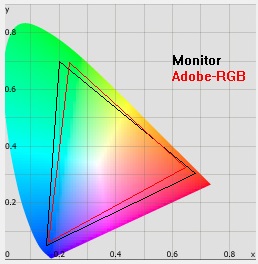
We have also provided a comparison of the
screens native colour space against the wider Adobe RGB reference in this standard preset mode. You can see that it extends
beyond the Adobe RGB reference as well in some shades, particularly reds and
some greens, but does fall
slightly short in other parts of the green spectrum, giving rise to the quoted 99% Adobe RGB
coverage. We will test if the Adobe RGB space can be more closely matched using
the defined Adobe RGB mode in a moment as well.

Default gamma was recorded at 2.3 average, leaving
it a little out with a 4% deviance from the target of 2.2 which wasn't too bad. In
darker grey shades the gamma was closer to 2.2, but it deviated a little higher
up to 2.36 in lighter grey shades. White point was quite close to the target
which was good, being slightly too cool and recorded at 6621k
(2% out). Note that we are using a
spectrophotometer to make these measurements which is not sensitive to the LED
backlight as some colorimeter devices can be. When using a standard gamut colorimeter
not designed to work with modern backlighting units like W-LED, WCG-CCFL and
GB-LED there can be a typical deviance of 300 - 600k in the white
point measurement which is why some sources may refer to a different white point
in this test incorrectly. We had seen a slightly better default set up here than
we had with the 27" U2713H which had a larger gamma deviance (2.5 average, 15% out)
and a larger white point deviance (6091k, 6% out). This was very similar on the
U3014 as we'd seen from the 24" U2413 though.
Luminance was recorded at a bright 250
cd/m2 which is
too high for prolonged general use. The screen was set at a default 50%
brightness in the OSD menu but that is easy to change of course to reach a more
comfortable setting. The black depth was a good 0.24 cd/m2, giving us a
very good (for an IPS panel) static contrast ratio of
1041:1. This was better than we'd seen from the 24" and 27" versions in fact
which were ~840:1.
Colour accuracy was poor in this measurement but
this is a result of the monitors native gamut, being much wider than the
reference sRGB. DeltaE was recorded at 3.5 average, with maximum of 9.6.
Testing the screen with various gradients showed smooth transitions with no sign
of any banding thankfully. The usual slight gradation was evident in darker tones as
you will see from most monitors.
We also tested the default performance in the
'custom color' preset for reference which on the U3014 was exactly the same as
the standard preset by default.

Factory
Calibration

Like its predecessor (U3011), the Dell U3014 comes
factory calibrated to some extent, and the box even includes a calibration
report from Dell specific to the unit you have. It states that every unit is
shipped incorporating pre-tuned sRGB and Adobe RGB modes which offers an average DeltaE of <2.
This is better than on the old U3011 in fact which only featured a factory
calibrated with dE < 5. In addition to this, they have tweaked gamma and
grey-scale to help to ensure smooth gradients and an accurate initial setup. As a new extra they have also
apparently adjusted luminance and colour uniformity across the screen which is available
from within the OSD as the uniformity compensation option which we will
test later on.
We've included a copy of the
calibration report from the Dell factory below for you to review. Note that this
report is only relevant to our specific test unit and they do state that results
may vary with each setup and different test equipment.

We were interested to see if this factory calibration helped at all with default
settings. Note that this is only relevant for the sRGB and Adobe RGB preset
modes available through the OSD menu. You will need to change from the default
'Standard' profile to benefit from these factory calibrated settings.

Dell U3014 - Default Factory Calibration, Adobe RGB mode
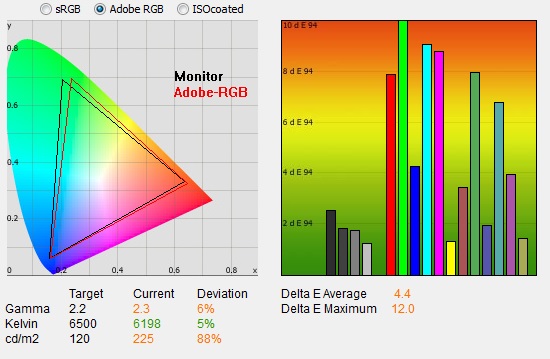
|
|
Default Factory Calibration,
Adobe RGB |
|
luminance (cd/m2) |
225 |
|
Black Point (cd/m2) |
0.23 |
|
Contrast Ratio |
975:1 |
The factory calibration of the Adobe RGB preset mode
was a little disappointing compared with the U2413 and U2713H we've already
tested. On those models this mode actually offered a very reliable
emulation of the Adobe RGB colour space, helping to cut back the slight
oversaturation of the screens native colour space. However, it seems that on the
U3014 this doesn't work quite as well. If you compare the CIE diagrams (below)
you can see that the oversaturation in reds has been cut back nicely to match
the Adobe RGB reference more closely, but there is still some over-coverage in
greens as before.
Comparison of Adobe RGB colour space
coverage in Standard preset mode (native gamut - left) and in Adobe RGB
emulation mode (right)
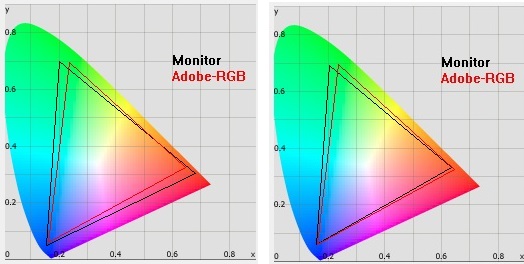

The average gamma was slightly further adrift than
the default
standard mode as it was now 6% out from
the target at 2.3 average. White point was also now slightly further away from the
6500k target, and was measured at 6198k (5% out). Luminance was
still too high but a simple OSD brightness change can of course overcome this though so
this is no big issue. Contrast ratio remained similar to the standard preset
mode at 975:1, being just a little lower (1040:1 in standard mode). Colour
accuracy (as compared with sRGB) was still off in this measurement due to the wide gamut of the screen, with a dE average of
4.4 and maximum of 12.0. We didn't feel this Adobe RGB mode was as well factory
calibrated as on the smaller U2413 and U2713H models and the Adobe RGB colour
space emulation didn't work quite as well as hoped.

Dell U3014 - Default Factory Calibration, sRGB mode
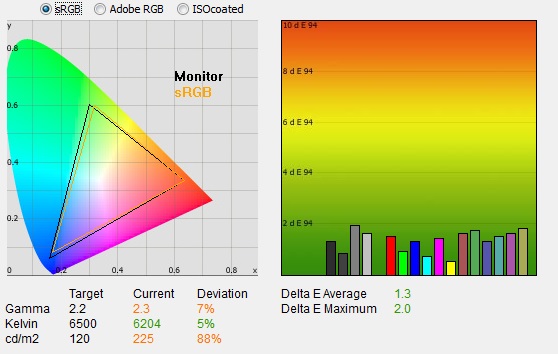
|
|
Default Factory Calibration,
sRGB mode |
|
luminance (cd/m2) |
225 |
|
Black Point (cd/m2) |
0.23 |
|
Contrast Ratio |
975:1 |
The factory calibration of the sRGB preset mode
was pleasing though. This mode offered a reliable emulation of
the sRGB colour space, helping to cut back the large oversaturation of the
screens native colour space and now very closely matching the sRGB reference.
This might be useful for colour critical work in the sRGB colour space and also
for those who want to avoid complications with wide gamut and colour management,
not to mention with movies and games.

The gamma was still a little out from the target
of 2.2, being measured at 2.3 average (7% deviance). The white point was again
slightly worse
than the default mode, now being measured at 6204k and being 5% out. Luminance was still
too high, but easy enough to adjust through the OSD menu. The contrast ratio was
the same as in the Adobe RGB mode and only slightly lower than the standard
preset at 975:1. Since we are now working with an sRGB
colour space the colour accuracy tests are more useful since they are based on
an sRGB reference. The dE average was 1.3 and maximum was only 2.0. This
represented a very good accuracy from the factory calibration. We would have liked a
slightly more accurate gamma setup in this mode, but the
emulation of the smaller colour space and the accuracy of the colours was very
pleasing.

Colour Temperatures

Like the other two new UltraSharp models, the
U3014 features a range of colour
temperature
presets within the OSD 'color settings' menu as shown above. You have to choose
the specific 'color temp' preset mode first but you are then asked to define
your target colour temp from the 6 presets available. We measured the screen
with the X-rite i1 Pro spectrophotometer in each of the preset modes to establish
their colour temperature / white point. All other settings were left at factory defaults and no
ICC profile was active. The results are recorded below:
|
Selected Preset Mode (k) |
Measured Colour Temperature (k) |
Deviance from target (k) |
Deviance |
|
10,000 |
9291 |
-709 |
-7.1% |
|
9300 |
8775 |
-525 |
-5.6% |
|
7500 |
7288 |
-212 |
-2.8% |
|
6500 |
6707 |
207 |
3.2% |
|
5700 |
5966 |
266 |
4.7% |
|
5000 |
5237 |
237 |
4.7% |

Some of the colour temperature modes offered reasonable
levels of accuracy. Overall there was a maximum deviance from the target of only
7.1% which wasn't too bad (10,000k setting). The middle settings of 7500 and
6500k were closer to their targets which are probably the more commonly used
modes anyway. The warmer presets remained pretty close to their target, within
266k maximum deviance. The cooler settings strayed further away from their
required temperature. Overall the
preset colour temp modes were reasonable really although not as accurate as
you might see on some other high end pro grade screens from the likes of
Samsung, NEC and Eizo.

Software Calibration
The U3014 may well have a
decent factory setup in some modes but given the market for this screen I
expect many users will want to calibrate the screen personally to obtain even
higher levels of accuracy and allow profiling and matching between different
devices. Remember, you need to ensure you have a calibration device capable of measuring
and reading the spectra from the GB-LED backlight unit properly. Many older
colorimeter devices are designed to work with standard gamut CCFL units only and
so they can often have difficulty reading LED (and wide gamut CCFL) units
properly. A spectrophotometer does not have this problem and there are also some
decent modern colorimeters like the X-rite i1 Display Pro which should be able
to read LED without issue. While you can use other devices and various software
packages to complete software profiling of the screen, you may come across
issues if the device is not designed to work with an LED backlight unit.
The U3014 also offers
hardware calibration which can give you very high levels of accuracy and
control over the monitors 14-bit LUT itself. We will look at that in a moment,
but we also wanted to carry out the usual software level "calibrations"
(profiling) at a graphics card level. We used the
X-rite i1 Pro spectrophotometer combined with the LaCie Blue Eye Pro
software package to achieve these results and reports. An NEC branded and
customised X-rite i1 Display 2 was used to validate the black depth and contrast
ratios due to lower end limitations of the i1 Pro device.
|
Monitor OSD Option |
Calibrated Settings |
|
Brightness |
23 |
|
Contrast |
50 |
|
Preset mode |
Custom Color |
|
RGB (Gain) |
99, 92, 99 |

Dell U3014 - Calibrated Settings, Custom Color Mode
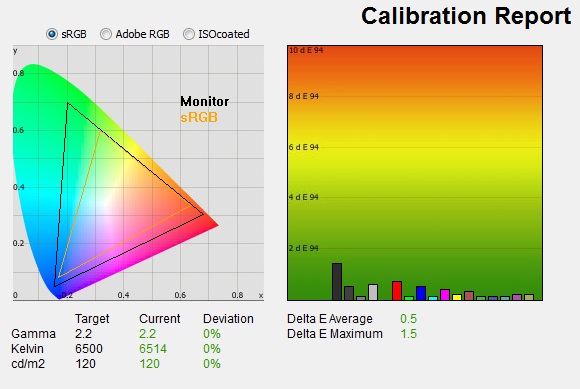
|
|
Calibrated Settings, Custom Color mode |
|
luminance (cd/m2) |
120 |
|
Black Point (cd/m2) |
0.15 |
|
Contrast Ratio |
810:1 |
We first of all reverted to the 'custom color'
mode in the preset section of the OSD menu. This retains the monitors full
native gamut and would allow us access to the individual RGB channels. There is
actually a very wide range of controls here if you need them for gain, offset,
hue and saturation, allowing the user to make finite adjustments where
necessary. Adjustments were made during the process to the brightness control,
and to the RGB channels as shown in the table above. This allowed us to obtain an
optimum hardware starting point and setup before software level changes would be
made at the graphics card level. This would help preserve tonal values and limit
banding issues. After this I let the software carry out the LUT adjustments and create an
ICC profile.

Average gamma had been corrected to 2.2 according to the initial test, correcting the default 4% deviance we'd
found in this preset (same as in the standard mode). The white point was also
corrected to 6514k, sorting out the small 2% deviance we'd seen before. Luminance had also been corrected thanks to the adjustment
to the brightness control, now being measured at 120
cd/m2.
This also gave us a calibrated black depth of 0.15 cd/m2, and a
static contrast ratio of 810:1 which was decent for an IPS panel. Colour
accuracy had also been corrected nicely, with dE average of 0.5 and maximum of
1.5. LaCie would consider colour fidelity to be excellent.
Testing the screen with various colour gradients
showed mostly very smooth transitions. There was some slight gradation in darker tones
and some very slight banding introduced due to the adjustments to the graphics
card LUT from the profilation of the screen. Nothing major at all though.
You can use our settings and
try our calibrated ICC profile if you wish, which are available in
our ICC profile database. Keep in mind that results will vary from one
screen to another and from one computer / graphics card to another.

Dell U3014 - Calibrated Settings, Adobe RGB Mode
|
Monitor OSD Option |
Calibrated Settings |
|
Brightness |
23 |
|
Contrast |
50 |
|
RGB Channels |
n/a |
|
Preset Mode |
Adobe RGB |
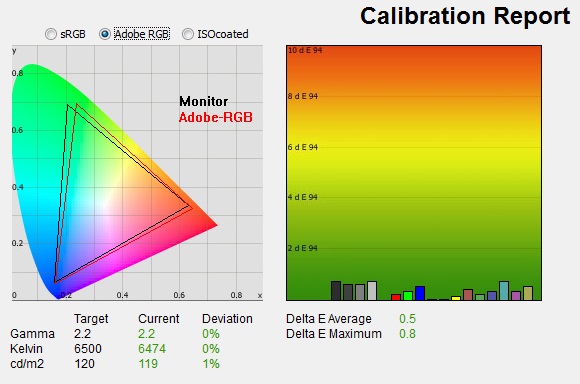
|
|
Calibrated Settings, Adobe
RGB mode |
|
luminance (cd/m2) |
119 |
|
Black Point (cd/m2) |
0.14 |
|
Contrast Ratio |
857:1 |
We also carried out the same process in the Adobe
RGB
preset mode. This mode was
factory calibrated
out of the box but had not offered quite the level of accuracy we had hoped for
really. It had failed to accurately match the Adobe RGB colour space really,
only cutting back some of the oversaturation in reds, but leaving us with some
over-coverage in green shades. There was also some slight deviation in gamma
(6%) and white point (5%) which was actually a little worse than the standard
preset mode which carried no factory calibration (4% gamma, 2% white point
variance).
The software calibration helped correct the 6%
deviance we'd seen by default in the gamma. We also corrected the 5% white point
deviance from the factory setting. Contrast ratio was now being measured at
857:1 after profiling which was good for an IPS panel. Colour accuracy had been
corrected, now with a 0.5 dE average and maximum 0.8 measured when validating
the produced profile. Testing the screen with various colour gradients showed
smooth transitions on the whole, with some slight gradation and some slight
banding in some darker shades due to the graphics card corrections made.
You can use our settings and
try our calibrated ICC profile if you wish, which are available in
our ICC profile database.

Dell U3014 - Calibrated Settings, sRGB Mode
|
Monitor OSD Option |
Calibrated Settings |
|
Brightness |
23 |
|
Contrast |
50 |
|
RGB Channels |
n/a |
|
Preset Mode |
sRGB |
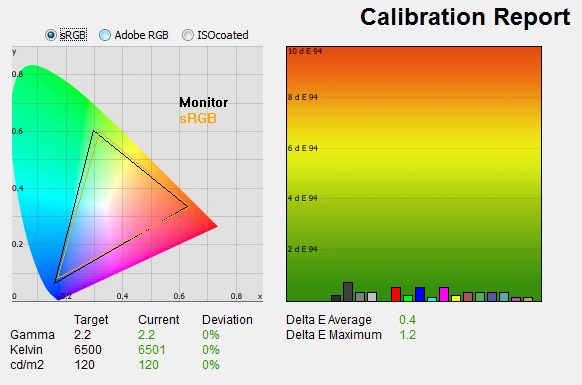
|
|
Calibrated Settings,
sRGB mode |
|
luminance (cd/m2) |
120 |
|
Black Point (cd/m2) |
0.14 |
|
Contrast Ratio |
869:1 |
We also carried out the calibration in the
monitors 'sRGB' emulation mode. Here you do not have access to the RGB channels
at all, and so the only hardware changes being made are to the brightness
control. The other corrections would be carried out at a graphics card LUT level
through the profiling process. However this would of course allow you to work
with the smaller sRGB colour space which we'd already established was being well
emulated in this preset.
The results were again very pleasing. The target for gamma had
been met nicely, correcting the 7% deviance we'd seen out of
the box. The white point had also been corrected to 6501k, sorting out the 5%
deviance we'd seen before. The luminance had been corrected to the desired level
with the change in the brightness control, and the static contrast ratio was a
good 869:1 after calibration. Colour accuracy had been corrected from the
already very good dE 1.3 average we had seen out of the box
thanks to the factory calibration, now down to 0.4 dE average.
Testing the screen with various colour gradients showed smooth transitions
on the whole, with some slight gradation and some very slight banding in some
darker
shades due to the graphics card corrections made.
You can use our settings and
try our calibrated ICC profile if you wish, which are available in
our ICC profile database.

Hardware
Calibration
Updated 29 October 2014
One thing which separates this screen from many
mainstream monitors, including the previous Dell 30" offerings, is the support
for hardware calibration. Users can program the monitors 14-bit Look Up Table
(LUT) if they have the appropriate software and hardware to achieve higher
levels of accuracy, something which professional users require and one of the
reasons why pro-grade screens from NEC and Eizo have always been popular in such
markets. The software part of is easy, Dell provide their own free "Color
Calibration Solution" software which is available to
download from Dell.com. This is a piece of software made
for Dell by X-rite and allows the user to access the hardware LUT to calibrate
the screen in two available modes. Currently the latest version is
v 1.5.3 for Windows operating systems (Win 7, 8, 8.1). There is also now a
Mac OS version available
here. These versions should work with all the hardware calibration
supporting UltraSharp models, despite the download page only listing the UP2414Q
and UP3214Q.
Important: The second part is not so easy however as you
require a compatible calibration tool to work with this software and allow
hardware calibration. Dell, or rather the software provider X-rite, have locked this so that you can ONLY use the X-rite i1 Display Pro colorimeter,
or i1 Pro / i1 Pro 2 spectrophotometers. Other devices are NOT compatible at all,
including the i1 Display 2, ColorMunki, Spyder
series or any other colorimeter. The software was co-designed between Dell and
X-rite and X-rite have recommended the use of the i1 Display Pro or i1 Pro
devices with the wide
gamut backlighting.
Users who already have another type of
colorimeter will be disappointed as although they will be able to software
calibrate their screen (profiling) as we have done in the previous sections as
normal, they will not be able to use it for the all-important hardware
calibration. I'm sure consumers will argue they should not need to buy a new
colorimeter to use with this screen and that other devices should be compatible.
We would be inclined to agree, but unfortunately the reality is that you can only
take advantage of the hardware calibration of the U2413 (or 27" U2713H / 30"
U3014) if you have a compatible X-rite device. If you don't own any device yet,
these are obviously the ones
to get for these displays.

We have already looked at the Color Calibration software
in some detail in our Dell U2713H review (v1.0.0.0 at time of writing), so please see
the relevant section there if you want more information and screen shots.
When calibrating at the hardware level you can choose whether you are going to
calibrate either CAL1 or CAL2 modes, and once you've done so you can quickly and
easily switch between them from within the monitors OSD in the preset section.
This allows you to set up a couple of custom modes, perhaps working with
different colour spaces (sRGB vs. Adobe RGB for instance) or with different
target white points, gamma curves or luminance levels (if you use the custom
mode). The options to select
these pre-defined colour spaces are shown above, and you can also specify your
target luminance. The whole process from there is automated and completely
controls the screen for you without the need for you to manually change
anything. The Dell software itself lacks any kind of reporting or validation
stage and so it can be tricky to verify what you have ended up with. You would
need a third party piece of software in order to carry out further validation
tests, and something like BasICColor Display (with a free 14-day trial) would be
a good option.
Update 14/1/14 - As we have
learnt from our more recent review of the
Dell UP3214Q, Dell and X-rite have now updated their calibration software
package to include some validation and reporting elements which brings the
software more in line with their i1 Profiler package. See our UP3214Q review for
more information.

First of all we hardware calibrated the screen
using the X-rite i1 Display Pro and selecting the 'native' colour space mode,
and a target luminance of 120
cd/m2.
Once calibrated we tested the screen again using
the test and report functionality from within LaCie's Blue Eye Pro software and
used our i1 Pro spectrophotometer to see how well setup the hardware calibration
seemed to be.

Dell U3014 - Hardware Calibrated Settings, Native Gamut Mode
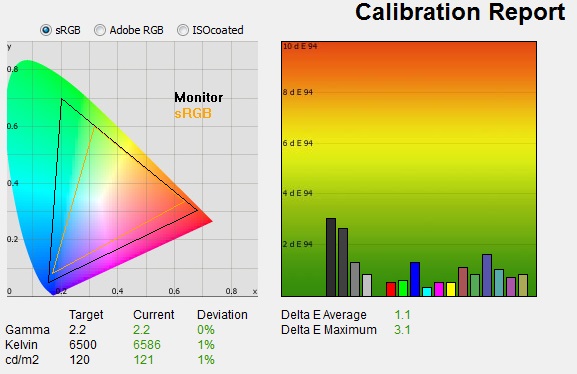
|
|
Hardware Calibrated
Settings, Native Gamut |
|
luminance (cd/m2) |
121 |
|
Black Point (cd/m2) |
0.14 |
|
Contrast Ratio |
882:1 |
The screen has been kept at its native gamut, with
the colour space stretching beyond the Adobe RGB space and not being cut back at
all to any smaller emulated space. We can see that the gamma curve has been
corrected now, helping to address the 4% deviance we'd seen in the
monitors 'standard' preset mode (which is based on the full native gamut of the
backlight). The white point was measured at 6586k and so was close to our target of 6500k with a
1%
deviance. This was slightly better than the default setup which was 2% out. It
seems that the 'native' mode is at least achieving a white point of ~6500k which
is good.
The luminance had been
corrected pretty nicely here which was good, and the resulting contrast ratio of
882:1 was good still for an IPS panel, and better than we'd achieved in the
software
calibration tests using the monitors native gamut (810:1 when calibrating in the
'custom color' mode). Colour accuracy was also good with dE average
of 1.1. The hardware calibration was a success and had worked well. Colour
gradients showed smooth transitions with no visible banding. Unlike a software
calibration where some tonal values are lost and some slight banding is
introduced, this hardware adjustment to the monitors LUT can help produce very
smooth gradients thankfully.

Dell U3014 - Hardware Calibrated Settings, Adobe RGB Gamut
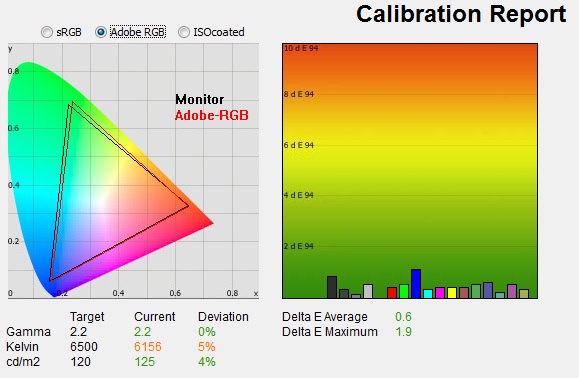
|
|
Calibrated Settings, Adobe
RGB mode |
|
luminance (cd/m2) |
125 |
|
Black Point (cd/m2) |
0.14 |
|
Contrast Ratio |
904:1 |
We performed the same process again, but this time
choosing the 'Adobe RGB' setting within the software. This is designed to
emulate the slightly smaller Adobe RGB space, much like the specific Adobe RGB
preset mode in the OSD menu. We had already tested the OSD preset mode based on
its
factory calibration and determined it had not emulated the required colour space
that well unfortunately,
been a little out in gamma (2.3, 6% out) and a little out in white point (6198k,
5% out). The somewhat poor match to the required Adobe RGB colour space had been the main
disappointment with the factory calibrated Adobe RGB preset mode really.
Through the hardware calibration in this mode we
can see that the monitors native colour space has been reduced a little, and
actually now more closely matches the Adobe RGB reference than the
factory calibrated Adobe RGB preset which was good news. Presumably the colour
coordinates defined in the software are even closer to the Adobe RGB space than those
used for the factory OSD preset. Gamma had been improved now to 2.2
average which was good, but white point was still only 6156k and 5% out from our
6500k desired white point. Perhaps this target mode is aiming for a 6000k
white point? There's no way to confirm in the Dell software what white point or
gamma you are aiming for unless you manually select them in the 'custom' mode. On
the other hand perhaps there are some discrepancies with the measurement of the
white point when using the i1 Display Pro with a GB-LED backlight system? Luminance had again been corrected pretty nicely, with the
small deviance likely down to the differences between the calibration tools. Contrast ratio was
904:1 which is a bit better than we'd seen from our
software
calibration as well. Again there was no visible banding from gradients
thanks to the finite adjustments to the hardware LUT.

Dell U3014 - Hardware Calibrated Settings, sRGB Gamut
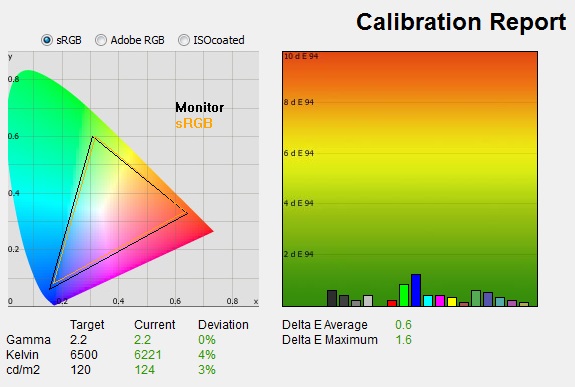
|
|
Calibrated Settings, sRGB mode |
|
luminance (cd/m2) |
124 |
|
Black Point (cd/m2) |
0.14 |
|
Contrast Ratio |
909:1 |
Lastly we used the sRGB option to calibrate to
this smaller colour space. This was emulated well and was actually slightly
closer to the desired gamut than that seen in the
factory
sRGB mode. Gamma was improved nicely correcting the 7% deviance and now at
2.2 average (0% out). The
white point was 6221k so again a little out from the target (4%) and no better
really than the
factory calibrated 6204k. Contrast ratio was
909:1 which was again better than we'd achieved through our software calibration.
Again there was no visible banding from gradients thanks to the finite
adjustments to the hardware LUT.

Hardware
Calibration Conclusion
Overall the process was pretty simple to use
although it did take a while for each calibration. The software is lacking any
kind of reporting feature which is a shame so you just have to trust that the
targets have been achieved, or find some other software which will allow you to
validate the results. The native mode left the screen at the full gamut of the
backlight as you'd expect, but the Adobe RGB and sRGB modes offered a reliable
emulation of the smaller colour spaces. In both cases they showed a more
accurate coverage of the target gamut when hardware calibrated than we'd seen
from the factory calibrated preset modes in the OSD menu. If you want the most
accurate coverage of Adobe RGB or sRGB then you want to be hardware calibrating
the screen if you can. This for us justifies the existence of the hardware
calibration feature on the U3014.
Gamma was corrected very well to 2.2 in all three
modes which was good news, correcting the slight 4 - 7% deviances we'd seen out
the box by default. The white point seemed to be 200 - 350k out when calibrated
in the Adobe RGB and sRGB modes. Perhaps this is down to white point measurement
inaccuracies when using the i1 Display Pro with a GB-LED backlight, or maybe the
targets defined in the software are not aiming for 6500k? The native mode
delivered a white point closer to the 6500k target though. All three modes
resulted in a calibrated contrast ratio higher than we had achieved through the
software level profiling which was good news. It was around 900:1 in each mode
which was very good for an IPS panel and again another good reason to hardware
calibrate the screen if you can.
As a side note, the uniformity compensation
feature is not available when using the CAL1 and CAL2 modes. We will look at that feature
later in the review but without meaning to spoil that section, it's not
really practical to use in reality anyway. It is a little odd however that Dell have not
made the two available together. Had the feature worked properly without its
current restrictions (as it did on
the
Dell U2913WM we've also tested), it would have been nice to be able to
combine it with the hardware calibration modes.
It's worth also commenting on the screen coating
in this section of the review. Unlike many other IPS panels, this screen does
not feature the usual heavy and aggressive Anti-glare (AG) coating which can
sometimes lead to grainy and dirty looking images. Instead it uses a light AG
screen coating and as a result the colours look more clean and crisp, the image
quality is sharp and whites in particular look more pure than they do on heavy
AG coated screens. It isn't a full glossy solution which adds another level of
clarity and changes the overall feel of the screen, but it is an improvement over the heavy
AG coating of some other IPS screens, including the previous Dell U3011. A
positive change and hopefully something we will start to see more of with future
IPS screens.

Calibration
Performance Comparisons

The comparisons made in this section try to give
you a better view of how each screen performs, particularly out of the box which
is what is going to matter to most consumers. When comparing the default factory
settings for each monitor it is important to take into account several
measurement areas - gamma, white point and colour accuracy. There's no point
having a low dE colour accuracy figure if the gamma curve is way off for
instance. A good factory calibration requires all 3 to be well set up. We have
deliberately not included luminance in this comparison since this is normally
far too high by default on every screen. However, that is very easily controlled
through the brightness setting (on most screens) and should not impact the other
areas being measured anyway. It is easy enough to obtain a suitable luminance
for your working conditions and individual preferences, but a reliable factory
setup in gamma, white point and colour accuracy is important and not as easy to
change accurately without a calibration tool.
From these comparisons we can also compare the
calibrated colour accuracy, black depth and contrast ratio. After a calibration
the gamma, white point and luminance should all be at their desired targets.
Default setup of the U3014 in the non-factory
calibrated "standard" mode was reasonable really. There was a small 4%
deviance in gamma, and a smaller 2% deviance in white point which was pleasing.
This mode operated in the full native colour space of the backlight of course,
but there are factory calibrated Adobe RGB and sRGB modes available too if
needed, with a reasonably reliable emulation of the smaller colour spaces. A
better match of the smaller colour spaces could be achieved through a hardware
calibration as well which was good news.


The calibrated black depth and contrast ratio of
the U3014 were good for an IPS panel, even
in different preset modes and colour spaces. We achieved 882:1 through the
hardware calibration at the native screen gamut and even a little higher at ~904
- 909:1 in the Adobe RGB and sRGB modes. The hardware calibrated contrast ratios
were also a bit higher than we'd achieved through our software calibration. The contrast ratio offered by the
U3014 should be
adequate for most users. Those needing a
higher CR may want to consider other technologies like AMVA.


Contrast
Stability and Brightness
We wanted to see how much variance there was in
the screens contrast as we adjusted the monitor setting for brightness.
In theory, brightness and contrast are two independent parameters, and good
contrast is a requirement regardless of the brightness adjustment.
Unfortunately, such is not always the case in practice. We recorded the
screens luminance and black depth at various OSD brightness settings, and
calculated the contrast ratio from there. Graphics card settings were left at
default with no ICC profile or calibration active. Tests were made using an
NEC branded and customised
X-rite i1 Display 2 colorimeter. It should be noted that we used the
BasICColor calibration software here to record these, and so luminance at
default settings may vary a little from the LaCie Blue Eye Pro report.
|
OSD Brightness |
Luminance
(cd/m2) |
Black Point (cd/m2) |
Contrast Ratio
( x:1) |
|
100 |
354.72 |
0.34 |
1043 |
|
90 |
335.17 |
0.32 |
1047 |
|
80 |
315.82 |
0.31 |
1019 |
|
70 |
298.21 |
0.28 |
1065 |
|
60 |
278.05 |
0.27 |
1030 |
|
50 |
260.07 |
0.25 |
1040 |
|
40 |
219.19 |
0.21 |
1044 |
|
30 |
178.58 |
0.17 |
1050 |
|
20 |
141.24 |
0.13 |
1086 |
|
10 |
92.89 |
0.09 |
1032 |
|
0 |
45.18 |
0.04 |
1130 |
|
Total Luminance Adjustment Range
(cd/m2) |
309.54 |
Brightness OSD setting controls backlight? |
 |
|
Total Black Point
Adjustment Range (cd/m2) |
0.30 |
|
Average Static Contrast Ratio |
1053:1 |
PWM Free? |
 |
|
Recommended OSD setting for 120 cd/m2 |
15% |
The luminance range of the screen was excellent.
At the top end the panel reached a high 354.72
cd/m2 which was even a
little higher than the specified maximum luminance of 350 cd/m2, and should
be more than most users
would ever need as
an upper limit. At the lower adjustment end it could
reach down to a low 45.18 cd/m2 which was even a bit lower than the specified
50 cd/m2 minimum. This meant the screen should be
perfectly fine even in darkened room conditions, and for those who like to run
at a lower luminance setting. A brightness setting of ~15% should return you a
default luminance of around 120 cd/m2 as well. Black point ranged
from 0.34 cd/m2 down to
0.04 cd/m2 with the backlight adjustments.

We have plotted the
luminance trend on the graph above. The screen behaves as it should, with a
reduction in the backlight intensity controlled by the reduction in the OSD
brightness setting. This was not a linear relationship though. As you can see
from the graph the settings between 100 and 50% actually controlled a slightly
less steep adjustment range between 354
cd/m2, and 260 cd/m2. From 50% downwards the
luminance changed more dramatically as shown by the steeper line on the graph.
This range from 50 to 0% allowed you to adjust the luminance from 260 all the
way down to 45 cd/m2, giving the user a more significant control over
the actual luminance of the display. As we discussed
earlier on in the
review, the dimming of the backlight is achieved through the use of
Pulse Width Modulation (PWM) but at a very high frequency (2500Hz) which is unlikely to produce visible flicker to
most users.

Average contrast ratio
in the standard default preset mode was measured was 1053:1 which was excellent
for an IPS panel really. It was pretty stable
across the adjustment range with some small deviations at the lower end of the
brightness scale.

Dynamic Contrast
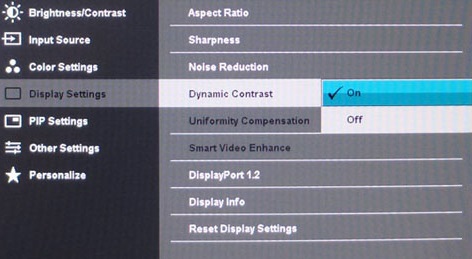
The Dell U3014 features a dynamic contrast ratio
(DCR) control, which boasts a spec of 2,000,000:1 (2 million:1). Dynamic
contrast ratio involves controlling the backlight of the screen automatically,
depending on the content shown on the screen. In bright images, the backlight
is increased, and in darker images, it is decreased. We have come to learn
that DCR figures are greatly exaggerated and what is useable in reality is
often very different to what is written on paper or on a manufacturers
website.
For this test I would use the colorimeter to record the
luminance and black depths at the two extremes. Max brightness would be
recorded on an almost all white screen. Black depth would
be recorded on an almost all black screen. In real use you are very
unlikely to ever see a full black or full white screen, and even our tests are
an extreme case to be honest. Carrying out the tests in this way does give you
a good indication of the screens dynamic contrast ratio in real life
situations however.
The DCR feature is available in only the movie
and game preset modes, and for some reason not in the multimedia preset. It
has a simple setting for on or off available from within the 'display
settings' section of the menu, and once enabled you cannot control the
brightness setting manually. If you do try to change it you are given a warning and the option to turn the DCR feature off.
|
|
Dynamic Contrast |
|
Specified DCR Range |
2 million: 1 |
|
Available in Presets |
Movie, Game |
|
Setting Identification / Menu option |
Dynamic Contrast |
|
Settings |
On / Off |
|
Measured
Results |
Movie mode |
Game mode |
|
Default Static Contrast Ratio |
649:1 |
1033:1 |
|
Max luminance (cd/m2) |
220.07 |
342.94 |
|
Min Black Point (cd/m2) |
0.11 |
0.11 |
|
Max Dynamic Contrast Ratio |
2008:1 |
3118:1 |
|
Useable DCR in practice |
Yes |
Yes |
|
Backlight turned off for 100% black |
Yes |
Yes |
We tested the DCR feature in both the movie and
game preset modes while at default settings (50% default brightness).
On these Dell screens you can observe the changes being made in the OSD by
looking at the energy meter in the top right hand corner. Switching to this mode
in normal office-type applications showed no initial change to the energy bar
and the screen seemed to remains at a luminance similar to the default 50%. When
switching between an almost all-white and an almost all-black screen there was
a noticeable change to the luminance of the screen even with the naked eye. When
moving to bright content the changes were faster, taking a couple of seconds
between each step in the OSD energy metre. When moving to darker content the
transitions were slower, taking about 10 seconds per step. Nevertheless, the DCR
was at least useable in practice and worked pretty well. The movie preset has a
pretty low static contrast ratio of only 649:1 though so that isn't as good as
some of the other preset modes. It returned a useable DCR of 2008:1 which was
reasonable, but this mode isn't ideal due to the reduced static contrast ratio.
You'd be better using one of the other presets for your movie viewing, and if
you want to use the DCR feature, go with the 'game' mode instead. That delivered
a static contrast ratio of 1033:1 which was much better and the DCR was higher
as a result as well at 3118:1. The only area which might make the DCR less
practical is the slow transitions when switching to dark content. If you're
viewing content which constantly changes then the DCR might not be able to keep
up or change enough to make it worth-while.
We tested the screen with a completely black
screen as well and after about 10 seconds the backlight was completely shut off. This would in theory give you a
better DCR (reaching the kind of figures the spec suggests) but it should be noted that it would be extremely
rare to ever see a 100% black image in real use, especially constantly for >10
seconds. So as we've become accustomed to, this is more of a theoretical DCR
than a realistic, practical DCR. Our tests of an almost all-black image are more
realistic for actual use.

Viewing Angles

Above: Viewing
angles shown from front and side, and from above and below. Click for
larger image
Viewing angles of the U3014 were very good as you
would expect from an IPS panel. Horizontally there was very little colour
tone shift until wide angles past about 45°. A red-ish hue affected the image
horizontally from wider angles as you can see above and there was also a shift
in contrast, which was more pronounced the wider you went. Contrast shifts were slightly more
noticeable in the vertical field but overall they were very good. The screen
offered the wide viewing angles of IPS technology and was free from the very
restrictive fields of view of TN Film panels, especially in the vertical plane.
It was also free of the off-centre contrast shift you see from VA panels and a
lot of the quite obvious gamma and colour tone shift you see from some of the
modern AMVA and PVA offerings. All as expected really from a modern IPS panel.
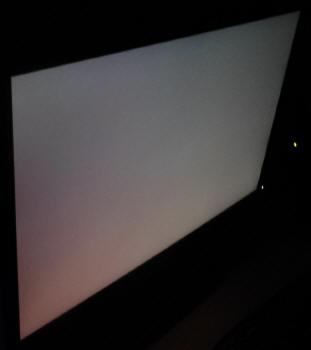
Above: View of an
all black screen from the side. Click for larger version
On a black image there is a characteristics IPS
white glow, but in normal working conditions this shouldn't present much
problem. The above image was taken in a darkened room to demonstrate the white
wide angle glow when viewing a black screen. There is no A-TW polarizer on this panel which is rarely used
now in the market but was implemented on some older screens to improve the off
centre black viewing.
If you are viewing dark content from a close
position to the screen you can see this pale glow on parts of the
screen towards the sides and corners because of your proximity to the screen and
your line of sight. The edges of the screen are at an angle from your line of
sight which means you pick up this white glow to a degree. This is often
referred to as "IPS glow". This
disappears as you move backwards away from the screen where the line of sight
does not result in a wide angle view of parts of the screen and you can see the
screen largely from head on. This glow should
not be mistaken for backlight bleeding which would not disappear as you changed
your line of sight or angle of viewing. Because of the very large screen size
this IPS glow is more apparent than on smaller models (23 - 24" for instance)
since the screen stretches further out of your line of sight in all directions.
In normal day to day uses this shouldn't be an issue but you might want to keep
this in mind if you're viewing a lot of dark content from close up. To be honest
though this can affect most IPS panels anyway and won't be a big issue to most.

Panel Uniformity
We wanted to test
here how uniform the brightness and colour temperature was across the screen, as well as identify any
leakage from the backlight in dark lighting conditions. First of all
measurements of the luminance were taken at 35 points across the panel on a pure
white background. The measurements for luminance were taken using BasICColor's calibration
software package, combined with the NEC customised X-rite i1 Display 2
colorimeter. Measurements for colour temperature (white point) were taken using
BasICColor software and the i1 Pro spectrophotometer which can more accurately
measure white points of different backlighting technologies.
The below uniformity diagram shows the difference, as a percentage,
between the luminance recorded at each point on the screen, as compared with the
central reference point of a calibrated 120 cd/m2. This is the desired level
of luminance for an LCD screen in normal lighting conditions, and the below
shows the variance in the luminance across the screen compared with this point.
For colour temperature uniformity we leave all settings at default in the OSD
menu and ensure no ICC profile is active. Again the uniformity is expressed as a
percentage deviation from the central measurement of the screen.
It is worth noting that panel uniformity can vary from one screen to another,
and can depend on manufacturing lines, screen transport and other local factors.
This is only a guide of the uniformity of the sample screen we have for review.
Like the other new UltraSharp models, the U3014
features a uniformity compensation feature which we will test here as well, but
first of all we left this setting off.

Luminance Uniformity
Uniformity of Luminance
Uniformity Compensation = Off
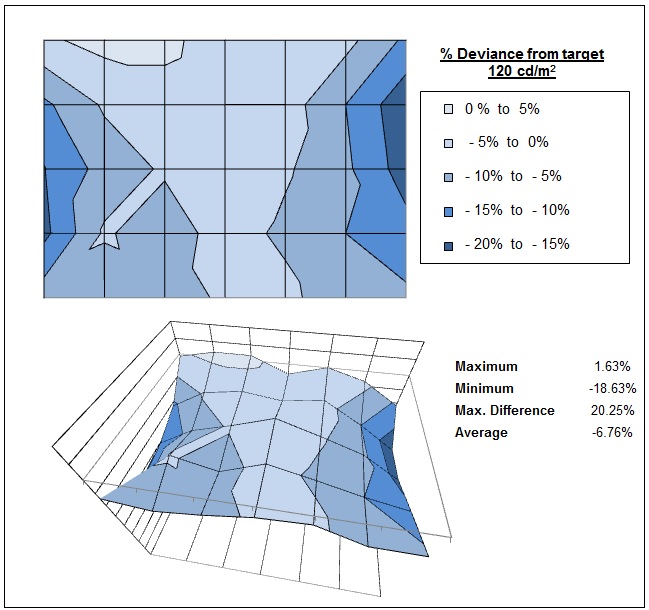
The luminance uniformity of the U3014 was
good on the most part. There was some darker periods along the left
and right hand edges where the luminance dropped down to 103
cd/m2
as a minimum (-18.63%). Overall around 83% of the screen was within a 10%
variance from the central measurement which was not bad.

Uniformity Compensation Feature
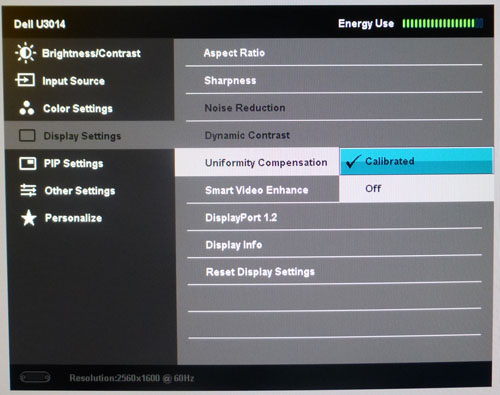
Like the 24" and 27" models the U3014 features a uniformity compensation
feature within the OSD menu as shown above. This isn't something Dell have
made much fuss of oddly, but it's a feature again normally reserved for
pro-grade screens. We've seen similar technologies used on NEC and Eizo
screens in the past with some positive results. The Dell manual states:
"Uniformity Compensation adjusts different areas of the screen with respect
to the centre to achieve uniform brightness and colour over the entire
screen. For optimal screen performance, Brightness and Contrast for some
preset modes (Standard, Color Temp) will be disabled when Uniformity
Compensation is turned On. When Uniformity Compensation is turned On, Energy
Smart cannot be activated. NOTE: Screen Uniformity performance is optimized
at default out of factory luminance setting."
On the U2413
and U2713H we'd seen
options available for "calibrated" and "user" as well as an
"off" setting. The
calibrated option represents a factory setup and as per the manual this is
optimised when in the screens default setup and at the default 50%
luminance. The 'user' feature was abandoned late in development on these new
UltraSharp screens and is not available, with no plans to make it available.
It has actually been removed from the OSD menu of the U3014 which is good,
so there's only the two options (calibrated and off) available here as you
can see above.
We had
seen from
the U2713H testing that this uniformity compensation mode seemed to do
nothing in reality to change the actual performance of the screen. When
switching to the "calibrated" mode you could see a visible change in the
brightness of the screen but when verifying the variations across the screen
with a colorimeter, no improvements had been made. This was a disappointment
certainly, especially when we then later tested the
Dell U2913WM which had the same feature which seemed to work pretty
well. When we then
tested the feature on the U2413 we found it did help improve the already
pretty decent luminance uniformity of the screen but concluded it was
largely pointless in practice. It could not be used in the factory
calibrated preset modes (Adobe RGB and sRGB), or in the hardware calibrated
modes (CAL1 and CAL2) which are surely the modes most users are going to
use. If you then wanted to use it in one of the other modes (e.g. standard
preset),
you have to have the screen at a bright 50% brightness setting, and you
cannot change it from this. So really it's pretty useless in real use. It's
a shame, and it seems a very odd choice really considering the type of
screen this is. The same is true on the U3014 unfortunately. It can't be
used in any of the main user modes, and those where it can be enabled are
restricted to the default brightness setting which is too high for
comfortable use. We tested its effectiveness nevertheless for completeness.

Uniformity of Luminance
Uniformity Compensation = Calibrated,
Standard mode, locked 50% brightness
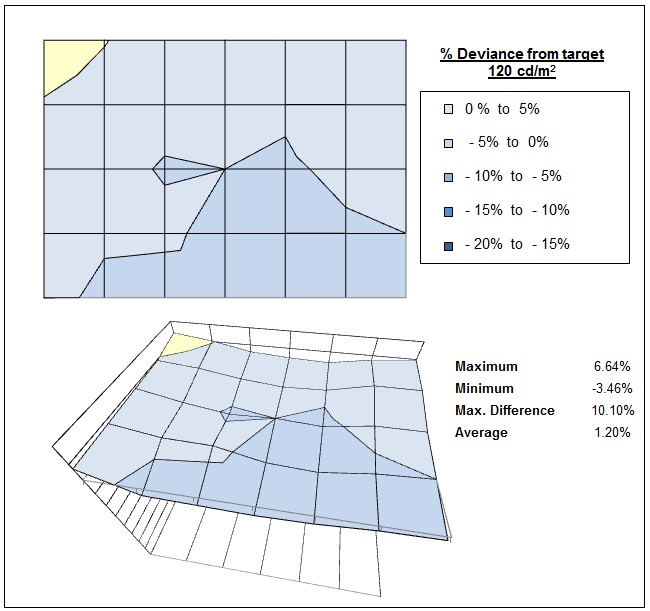
Interestingly this mode did seem to offer an
improvement in the overall luminance uniformity of the screen when it was enabled, just
like we'd seen from the U2413. We
now had smaller deviations of only 6.64% maximum in the top corners, being a
little brighter than the centre of the screen. 100% of the screen was now
within 10% deviance of the central point. However, because the brightness
was now locked and could not be changed, the screen was far too bright with
an average luminance of 242
cd/m2
across the screen. Unlike on the
U2713H, this does seem to work, but is pretty much pointless given the
locking of the screens brightness and the inability to use it in the
main user modes (Adobe RGB, sRGB, CAL1 and CAL2).
Colour Temperature / White Point
Uniformity
We also
carried out our tests in this area to establish how uniform the colour was
across the screen. We measured the white point (colour temperature) deviance
compared with a central measurement point at default settings. First of all
we carried out this test with the uniformity compensation feature turned
"off".

Uniformity of White Point / Colour
Temperature
Uniformity Compensation = Off
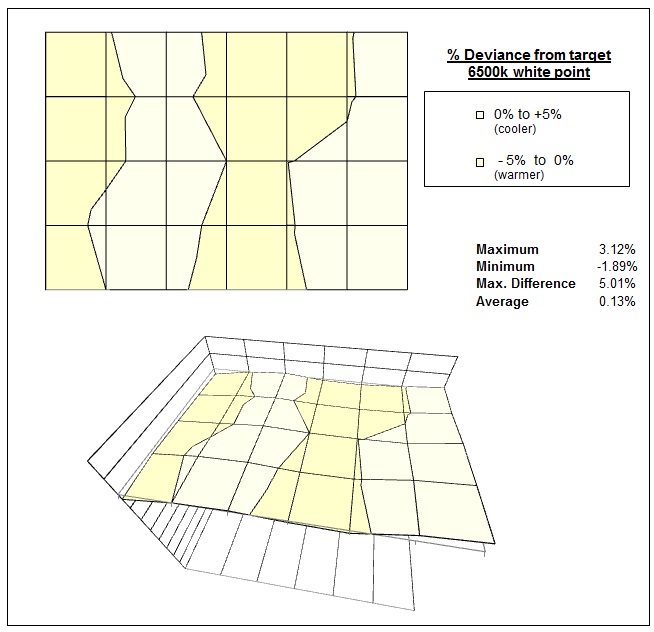
As you can see, the colour temperature was
pretty uniform across the panel with only small deviations across the
screen. There was a maximum of 3.12% deviance in the bottom right hand
corner, but the rest of the screen was within 2% of the central measurement
point. This was all with the uniformity compensation feature turned off,
indicating that even without it, the colour temperature was stable
thankfully.

Uniformity of White Point / Colour
Temperature
Uniformity Compensation = Calibrated,
Standard mode, locked 50% brightness
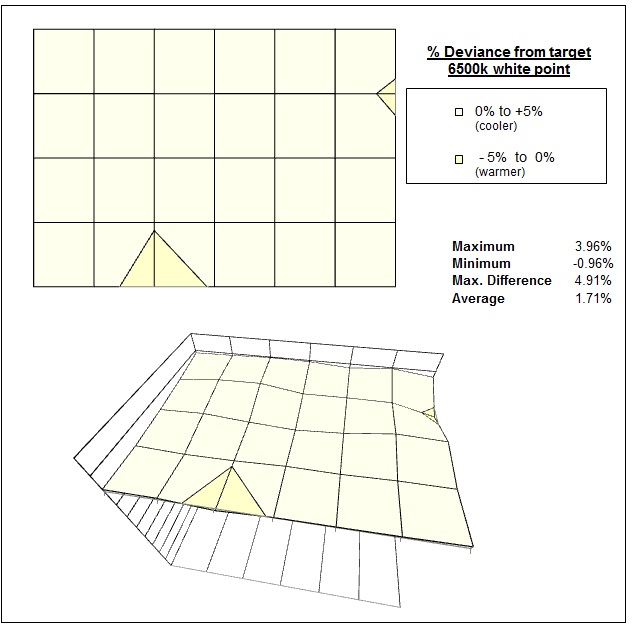
We then turned the uniformity feature back on
to 'calibrated' and ran the same tests. As you can see the results are
pretty similar, with some minor improvements made. As we've already said, the uniformity
compensation mode is pretty useless anyway because of the limitations you
then have in preset mode selection and brightness control.
We fail to
see the point in this feature at all on these new screens (U2413, U2713H and
U3014), and really hope Dell sort
this feature out for future screens (maybe future revisions of the U3014?)
Considering it worked well on the U2913WM, without any of these limitations
about locked brightness levels we are sure it must be possible for Dell to
get it working. Really you'd have hoped it would be a workable feature on
the U3014, U2713H and U2413 as opposed to on the U2913WM given they are supposed to
be the higher grade professional range screens. As it is, on the U3014 it
isn't available at all in the main preset modes you'd probably want to use,
and then when you do find a preset where it's available, you're then stuck
with a locked brightness which is far too high for any prolonged use. A
shame really as it does seem to work reasonably well on this screen in those
pretty tight guidelines.

Backlight Leakage
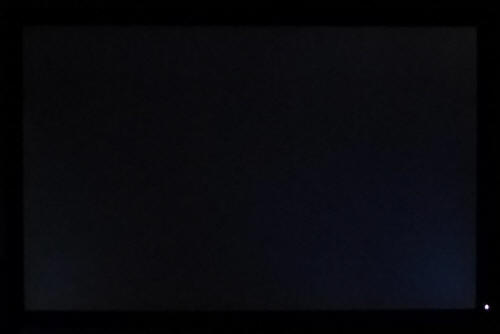
Above: All black screen in a darkened room. Click for larger version
As usual we also tested the screen with an all
black image and in a darkened room. A camera was used to capture the result.
There was no obvious backlight bleeding at all to the naked eye and the
uniformity looked very good, even in a darkened room. The camera captured some
slight clouding from the bottom corners, but this was
very slight and not something which you should notice in practice. A pleasing
result here.

General and Office Applications
The U3014 feature a massive 2560 x 1600 resolution
which is a little more vertically than the wide range of 2560 x 1440 res 27"
screens. The pixel pitch of 0.250mm is very small as a result, and by comparison
a standard 16:10 format 24" model has a pixel pitch of 0.270mm. It is however a
little more than the aforementioned 27" models (0.231mm). Some users may find
the small text a little too small to read comfortably, and I'd advise caution if
you are coming from a 19" or 22" screen for instance where the pixel pitch and
text are much larger. Personally I think this pixel pitch is about right by
modern standards, a little easier on the eye than the 27" models but a little
"tighter" than the smaller screens out there. The extra screen size also takes
some getting used to over a few days as there really is a lot of room to work
with. It's actually noticeably bigger than a 27" model as well. The massive
resolution is really good for office and general use, giving you a really big
screen area to work with. It is a noticeable upgrade from a 24" 1920 x 1200
resolution. For those wanting a high resolution for CAD, design, photo work etc,
this is a really good option. The image was very sharp and crisp and text was
very clear.
The light AG coating is also a very positive move
when it comes to these kind of uses and we had been pleased when Dell made this
switch before with some of the other recent models, notably the U2713HM which
was the first. The new lighter coating ensures that white backgrounds of office
documents looked good, and did not suffer from the overly grainy and dirty feel
of some competing IPS panels featuring heavy, aggressive AG coating - including
the old U3011. It also remained free from the reflections you might experience
from a full glossy solution so seems to be a good half-way between the two. The
wide viewing
angles provided by the IPS panel technology on both horizontal and vertical
planes, helps minimize on-screen colour shift when viewed from different angles.
The
default setup of the screen was pretty reasonable in the standard mode, and the
factory calibrated Adobe RGB and sRGB modes were decent too, providing access to
the smaller colour spaces easily if needed. The option to choose between a wide
gamut or standard gamut colour space which was very useful, and many users may
prefer to use sRGB to avoid complications with colour management and
oversaturation of colours. If you follow our basic OSD adjustments from our
calibration
process (and maybe also try our calibrated ICC profile) you should be able
to get a better setup, even without a colorimeter of your own. Of course given
this is a high end screen aimed at professional users it is logical to expect
many people who purchase the screen will already have a calibration tool of
their own, or at least plan to buy one soon. With a calibrator you can of course
obtain even more accurate setups, including more accurate Adobe RGB and sRGB
colour space emulation, which is great news. You do need to be
wary of the limitations of the hardware calibration feature which
we
talked about earlier however. If you've not got a device yet and plan to buy one,
make sure you buy an X-rite i1 Display Pro if you want to use the hardware
calibration. That would also be a good device for use with other displays as
well.
There is a specific 'paper' preset mode available
within the OSD menu which makes the image darker and more yellow. This might be
useful to some for certain reading conditions, but with the wide range of
adjustments and modes available it should be easy enough to get an optimum setup
for your uses. Out of the box the luminance was too high and so you will want
to turn this down a fair amount to obtain a setting comfortable to you in your
lighting conditions. A setting of around 15% brightness should give you a
luminance of around 120
cd/m2 out of the box. The brightness
control affords you a good range of adjustments as well, allowing you to go up
to ~355 cd/m2 and down as low as ~45 cd/m2. Even those
wanting to use the screen in low light conditions should find the adjustment
range more than adequate. Another thing to note while we are talking about the
brightness control is that the screen does use
Pulse-Width modulation (PWM) to control backlight dimming but at a very high
frequency of 2500Hz. Those who suffer from eye fatigue or headaches associated
with flickering backlights probably shouldn't need to worry with a frequency this
high, but if you are particularly bothered by it you need to be aware it is used
here. The screen is free from the so-called "cross-hatching" issue which some
users noticed on the 27" U2713HM we should note.
Another issue
which some users reported from the U2713HM was image retention in some
circumstances. Often easy to re-create by leaving a white window on a black
background for a fair amount of time, and then switching to a grey background
where an after-image was left. We tested this on the U3014 and couldn't see any
issues ourselves. There was no audible noise from the screen and it was free
from the buzzing issue which you can notice on the U2713HM / U2713H in certain
uses. The screen offers a 4 port USB
3.0 hub which is useful, especially with 2 ports located on the left hand edge
for easy and quick access. There is also a 9-in-1 card reader which is good news
and something personally I've found useful on previous Dell models. Nice to see
it returning here for the U3014. There was a good range of ergonomic adjustments
available which were all pretty easy and smooth to use. The screen does not
offer a rotation function which is probably impractical at this size anyway so
isn't really missed. The VESA mounting support may also be useful to some
people. With DisplayPort and DL-DVI both supporting the full 2560 x 1600
resolution you should have a decent choice for your PC connectivity.
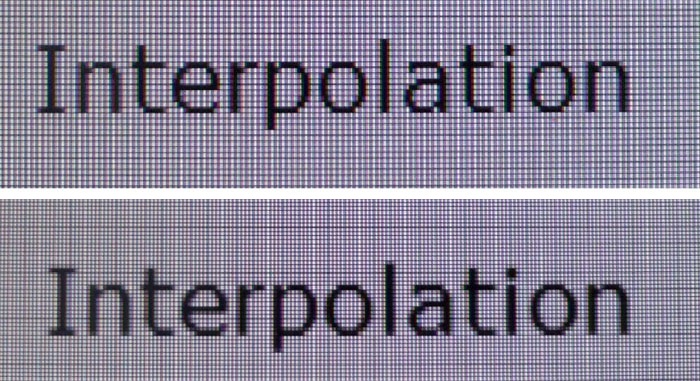
Above: photo of
text at 2560 x 1600 (top) and 1920 x 1200 (bottom)
The screen is designed to run at its native
resolution of 2560 x 1600 and at a 60Hz recommended refresh rate. However, if
you want you are able to run the screen outside of this resolution. We tested
the screen at a lower 1920 x 1200 resolution to see how the screen handles the
interpolation of the resolution, while maintaining the same aspect ratio of
16:10. At native resolution the text was very sharp as you can see from the top
photograph. When you switch to a lower resolution the text is larger of course
but actually still retains most of its sharpness. There is some slight blurring
of the text but it's not too severe. A decent performance really if you did need
to run outside of native resolution for whatever reason. We would recommend
native resolution wherever possible for maximum picture quality and screen
real-estate of course.
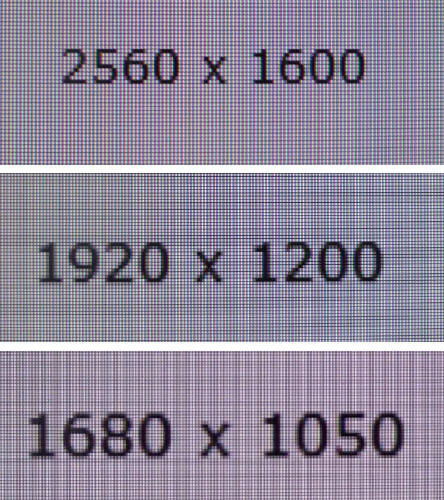
Above: photo of
text at different resolutions. Click for larger version
We've also tried to capture the text at each
resolution from close up but without zooming in on the text as we did in the
interpolation image. Might be useful to some readers for another comparison.

Responsiveness and Gaming
The U3014 is rated by Dell as having a 6ms G2G response time which implies the use of
overdrive /
response time compensation (RTC) technology, used to boost pixel transitions
across grey to grey changes. There is no user control over the overdrive impulse
within the OSD menu and so we are reliant once again on Dell's factory setup. The
part
being used is the
LG.Display LM300WQ6-SLA1 AH-IPS panel. Have a read about response time in
our
specs section if you need additional information about this measurement.
We will first test the screen using our thorough
response time testing method. This uses an oscilloscope and photosensor to
measure the pixel response times across a series of 20 different transitions, in
the full range from 0 (black) to 255 (white). This will give us a realistic view
of how the monitor performs in real life, as opposed to being reliant only on a
manufacturers spec. We can work out the response times for changing between many
different shades, calculate the maximum, minimum and average grey
to grey (G2G) response times, and provide an evaluation of any overshoot present
on the monitor.
We use an
ETC M526
oscilloscope for these measurements along with a custom photosensor device.
Have a read of
our response time measurement article for a full explanation of the testing methodology and reported
data.
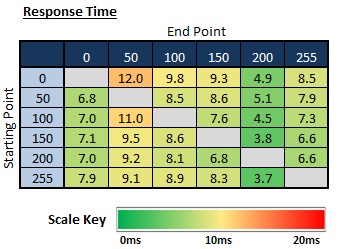
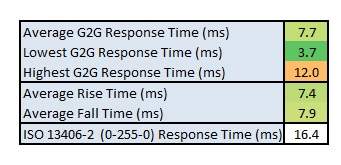
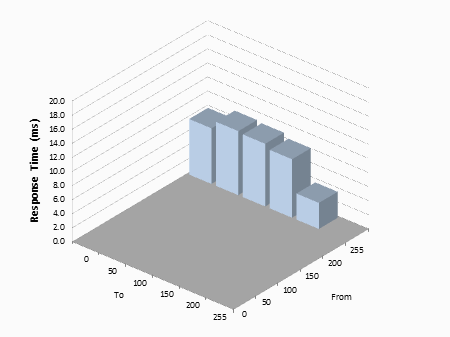
On the whole the pixel transitions were pretty
fast. The average G2G response time was measured at 7.7ms which was just a
little slower than the specified 6ms G2G from the manufacturer, but still very
respectable. Some black to grey changes (0-50, 0-100) were a little slower at
~10 - 12ms. There was only minimal difference between the average G2G rise time
(changes from dark to light shades) and the average G2G fall time (changes from
light to dark shades). Interestingly the changes to a light grey shades (x - 200)
were the fastest where it seems the overdrive impulse was being applied the most
aggressively. The overall story here was pretty similar to the other new Dell models, with
the U2413 having a 7.9ms average G2G response time and the U2713H having 7.2ms
G2G average.
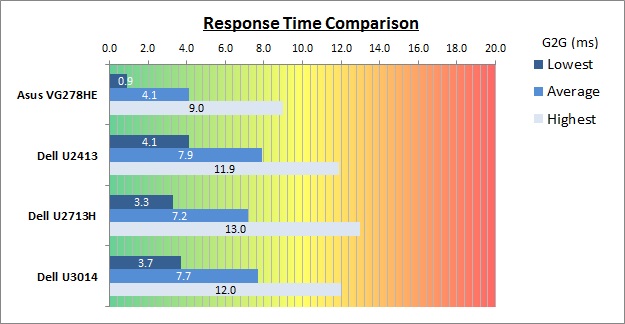
As we begin to measure more screens with the
oscilloscope system we can begin to plot them on a graph like the above for easy
comparison. This shows you the lowest, average and highest G2G response time
measurement for each screen. As you can see, the three new Dell screens are all
quite similar. The gamer-orientated and TN Film based Asus VG278HE is quite a
lot faster though.
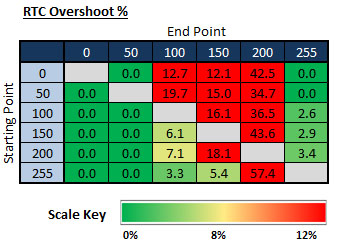
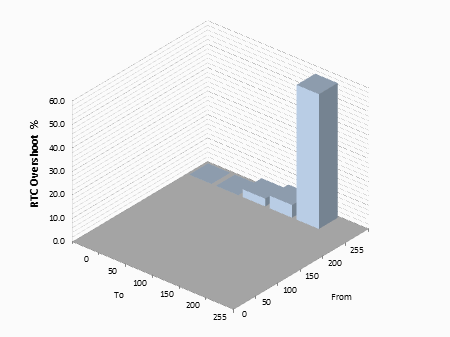
Unfortunately if we evaluate the Response Time
Compensation (RTC) overshoot then the results are not pleasing. There is some
significant overshoot evident with transitions from dark to light shades,
particularly when changing to light grey (x - 200). We had already noted that the
response time for these transitions was very low and it seems that the overdrive
impulse is being applied very aggressively here. While it may be speeding up the
pixel transitions it is causing a large degree of overshoot. For the changes to
200 the average RTC overshoot was a massive 42.9% which was not very good
at all and represented a significant issue. In practice this results in an obvious trailing image on certain
transitions which could prove distracting. This was worse than we'd seen from
the U2713H and U2413 as well where the RTC error was not as extreme, but still
pretty significant. The U2413 and U2713H seemed to show more error with changes
to white (x - 255) which had been pretty much eliminated here, but the error
when switching to light grey shades was far more of an issue.
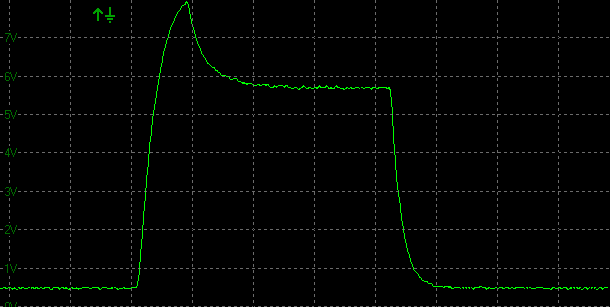
Transition: 0 - 200 - 0
(scale = 20ms)
The above oscillogram is a classic example of what
we saw. This is from the transition from 0 - 200 - 0. There was a fast rise
time from dark to light shade (4.9ms) but an obvious overshoot was introduced
(42.5%) shown by the peak exceeding the upper flat line. The fall time was a
little slower (7.0ms) but there was no overshoot from that transition from light
to dark. This was fairly typical of the overshoot characteristics of the U3014
where they were seen. Transitions from light to dark are
not affected by as much overshoot but there are still some errors with the transitions which
are close together (e.g. 200 - 150 and 255 - 200).
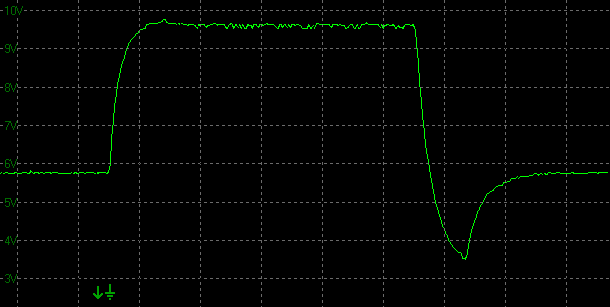
Transition: 200 - 255 - 200
(scale = 20ms)
In fact there was a huge error of 57.4% with the
change from 255 - 200 which was very severe, as shown above with the overshoot
after the fall time.
We can conclude that the
response times of the U3014 are pretty good, but the RTC overshoot may prove
problematic to some users. This will be particularly noticeable in transitions
from dark to light shades in practice and it seems Dell have been too aggressive
with their overdrive impulse in trying to cut back pixel rise times and this has
resulted in some quite problematic overshoot. For reference this was a very
similar picture to what we saw with the 27" U2713H and 24" U2413 which
shows similar pixel response times, and high levels of overshoot in transitions
from dark to light shades, so it seems they've had the same problems with all
three of the new models. It's a shame there is no option to disable the
overdrive impulse on these new screens really to eliminate any issues users
might experience.
Display Comparisons
The screen was also tested using the chase test in
PixPerAn for the following display comparisons. As a reminder, a series of
pictures are taken on the highest shutter speed and compared, with the best case
example shown on the left, and worst case example on the right. This should only
be used as a rough guide to comparative responsiveness but is handy for a
comparison between different screens and technologies as well as a means to
compare those screens we tested before the introduction of our oscilloscope
method.

30" 6ms G2G
LG.Display AH-IPS
In practice the Dell U3014 showed fairly low
levels of motion blur although some was detectable to the naked eye and picked
up in these tests. There was nothing severe and no obvious ghosting which was
good. In these tests we did not see any obvious overshoot problems which was
interesting but this is likely to be down to the colour transitions being made
in this program. The transitions are from light to dark shades with the movement
of the car and we know from our oscilloscope tests that there was minimal
overshoot in those circumstances. Thankfully our oscilloscope method allows us
to measure a wider range of transitions and provide a more complete picture.
Further tests with other moving images of different colours shows that the RTC
overshoot is quite varied and can manifest itself more
severely in the dark > light pixel changes.

30" 6ms G2G
LG.Display AH-IPS

27" 6ms G2G
LG.Display AH-IPS

24" 6ms G2G
LG.Display AH-IPS

27" 8ms G2G
LG.Display AH-IPS

29" 8ms G2G
LG.Display AH-IPS
We have also provided a comparison of the U3014 above
against four other recent Dell screens we have tested
which also use IPS panel technology. The U3014 was quite comparable in practice
to the
U2713H and
U2413 as you perhaps might expect, and our accurate response time measurements with the oscilloscope
system showed similar G2G response times and a similar story when it came to the
RTC overshoot issues with dark to light colour changes. The
U2713HM was a little faster with slightly less motion blur and freedom from
any overshoot problems. We have also verified the results for the U2713HM with
the oscilloscope. The 29"
U2913WM had also shown some decent responsiveness and was a little faster
than the U2413 and U2713H. Keep in mind that the new U2413 / U2713H / U3014
models are not really aimed at gamers and semi-professional grade monitors.
Nevertheless they should be able to handle some moderate gaming.

30" 6ms G2G
LG.Display AH-IPS

30"
7ms G2G LG.Display H-IPS

27" 5ms G2G
Samsung PLS (Response Time = Faster)

27" 6ms G2G
LG.Display H-IPS (Overdrive = On)

27"
7ms G2G LG.Display p-IPS
(response
improve = on)
We have also provided a comparison of the U3014
against the old
U3011 model as well as three 27" models aimed at the professional market.
The U3014 performed quite similarly to the old U3011 really in practice, with
similar levels of motion blur. There was more overshoot on the new model in some
transitions though due to an aggressive overdrive impulse. The
Samsung S27B970D with its PLS panel was a little faster still, with a
sharper moving image and lower levels of blur. The
Eizo SX2762W and
NEC PA271W also had fairly low levels of blur, but did exhibit some
noticeable dark overshoot trailing in these tests as you can pick out from the images
above.

30" 6ms G2G
LG.Display AH-IPS

27" 12ms G2G
LG.Display H-IPS

27" 5ms G2G
Samsung PLS (Trace Free = 40)

27" 12ms G2G
Samsung PLS (Response Time = Advanced)
We can also compare the U3014 against a few of the
other popular 27" 2560 x 1440 resolution models available. The
HP ZR2740w showed slower pixel response times with a more
pronounced blurring to the moving image. This is also reflected in the quoted
12ms G2G response time spec in fact. The
Asus PB278Q had showed very low levels of blur at the optimum Trace Free
setting of 40 and so was a little faster than the Dell U3014 here. The
ViewSonic VP2770-LED was also a little faster in practice when at its
optimum response time setting of 'advanced'. Both the Asus and ViewSonic were
also free from any obvious overshoot problems at these settings which made them
more suitable for gaming than the U3014 where the overdrive could not be turned
down to eliminate the overshoot problems unfortunately.

30" 6ms G2G
LG.Display AH-IPS

27" 2ms G2G Chi
Mei Innolux TN Film +144Hz (Trace Free = 60)

24" 2ms G2G AU
Optronics TN Film + 120Hz (AMA = On)

27" 1ms G2G Chi
Mei Innolux TN Film + 120Hz (Over Drive = 0)

22" 3ms G2G Samsung TN Film + 120Hz
We've also included a comparison above against
four very fast 120Hz+ compatible screens we have tested. In all cases these
other screens are using TN Film panels and are aimed primarily at gamers.
Firstly there is a comparison against the Asus VG278HE with its 144Hz refresh
rate. This showed very fast pixel response times and smooth movement thanks to
its increased refresh rate. You are able to reduce the motion blur even more
through the use of the LightBoost strobed backlight which we talked about in
depth in our article about
Motion Blur Reduction Backlights.
Then there is a comparison against the
BenQ XL2420T. This showed very low levels of motion blur, but some dark
overshoot was introduced as a side-effect. The
Iiyama G2773HS was very responsive and even has a quoted 1ms G2G response
time. This showed very low levels of blur and had minimal issue with overshoot.
The
Samsung SM2233RZ performed very well in these tests and showed very low
levels of motion blur also. When 120Hz mode was enabled the overdrive artefacts
evident in 60Hz mode were almost completely eliminated, which is something we
have seen with the BenQ XL2420T as well.
While these pixel response tests show the U3014 to
have reasonably fast transitions and fairly low levels of motion blur, there is something else going on as well here which can't be picked out by the camera. All of these other TN Film models are
running at 120Hz (or higher) refresh rates, which allows for improved 120fps+ frame rates and
the support of
3D stereoscopic content as well. This can really help improve smoothness and
the overall gaming experience so these screens still have the edge when it comes
to fast gaming. From a pixel response point of view the U3014 performed well,
although the overshoot in certain transitions was severe. There are some other
areas you still need to think about when it comes to high end gaming. It
couldn't keep up with the very fast TN Film models with 120Hz support and
certainly not with models using LightBoost systems for reducing perceived motion
blur.

Much like the smaller 24" U2413 and 27" U2713H
models, the responsiveness of the U3014 was pretty good
overall. We had measured a pretty low average G2G response time of 7.7ms which
was good, although we'd seen some high overshoot in certain transitions,
especially when changing from dark to very bright / white shades. In practice it
didn't feel quite as fast as some other models we'd tested like the U2713HM for
instance. Keep in mind though that this is aimed at higher
end uses and the semi-professional market and so the performance for gaming is
obviously not a number one priority for Dell. It should still be perfectly
adequate for most gaming, but those wanting to play fast FPS or competitive
games may want to consider some of the more mainstream (and more suitable)
models available, or better still, some of the 120Hz+ compatible displays out
there. Even better still would be models equipped with
LightBoost systems for optimum motion blur elimination.
On another note many gamers like to use exaggerated
settings to make colours look brighter and more vivid. Wide gamut screens can
serve this purpose well as they natively produces more saturated colours. This
might not be strictly accurate but a lot of people prefer this more vivid and cartoony appearance and so it's useful that the option is available from the
U3014. Of course if you want to revert to a standard gamut you can always
switch to the sRGB mode too.

Additional Gaming Features
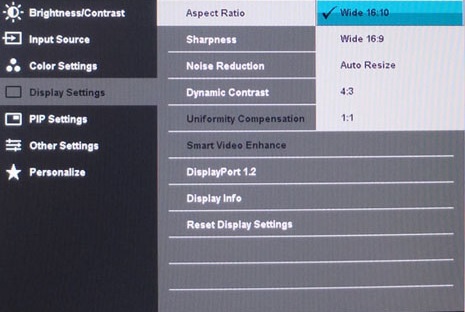
Aspect Ratio Control - The screen offers
five options within the OSD menu for hardware level
aspect ratio control which are the same as those found on the U2413 (also a
native 16:10 aspect ratio screen). There are options to maintain the aspect ratio at
'wide 16:10', 'wide 16:9' or '4:3' which users will hopefully be familiar with.
These will help maintain those specific aspect ratios for certain sources,
stretching the image to fill as much of the screen as possible and using black
borders to cover the sides (for 4:3 mode) or top and bottom (for 16:9 mode). It
was good to see 16:9 included as a specific option as a lot of content is based
on this format nowadays and that helps avoid complications with the fact the
screen is 16:10 natively.
There is also then an option for 'auto resize'
which retains the source aspect ratio no matter what it is, and fills as much of
the screen as possible (black borders used where needed). This is particularly
useful as it will automatically detect the aspect ratio and maintain it. The last option is for 1:1 pixel mapping which directly maps the source
resolution to fill only the required number of pixels. Again handy for those
wanting to maintain any source resolution and aspect ratio, without stretching
the image at all. These options are the same as those found on the old U3011
incidentally.
Preset Modes - There is a 'game' preset
mode available from within the preset mode menu. This seems to look quite
similar to the standard preset mode and it gives you access to the
dynamic contrast ratio if you want to use it, which for once actually works
quite well. This mode might be useful if you want
to set up a specific mode to be different to your day to day normal use profile
as well. As you will see from the
next section, it
also has a very positive impact on input lag. One odd thing we did notice when
using this mode (which another user alerted us to in fact) was that there
appears to be some slight "shimmering" across the image if you look very
closely, and some slight pixel walk vertically. This is particularly noticeable
at the very bottom of the screen where small, feint lines appear to be moving
slowly downwards. Perhaps this is related to the bypassing of some of the
internal electronics (to help reduce input lag). In normal uses and games you're
unlikely to see any negative affects of it, and you'd probably want to switch to
one of the other preset modes for normal day to day use anyway which don't
exhibit the same issue.

Lag
We have written an in depth article about
input lag and the various measurement techniques which are used to evaluate
this aspect of a display. It's important to first of all understand the
different methods available and also what this lag means to you as an end-user.
Input Lag vs. Display Lag vs. Signal
Processing
To avoid confusion with different terminology we
will refer to this section of our reviews as just "lag" from now on, as there
are a few different aspects to consider, and different interpretations of the
term "input lag". We will consider the following points here as much as
possible. The overall "display lag" is the first, that being the delay between
the image being shown on the TFT display and that being shown on a CRT. This is
what many people will know as input lag and originally was the measure made to
explain why the image is a little behind when using a CRT. The older stopwatch
based methods were the common way to measure this in the past, but through
advanced studies have been shown to be quite inaccurate. As a result, more
advanced tools like SMTT provide a method to measure that delay between a TFT
and CRT while removing the inaccuracies of older stopwatch methods.
In reality that lag / delay is caused by a
combination of two things - the signal processing delay caused by the TFT
electronics / scaler, and the response time of the pixels themselves. Most
"input lag" measurements over the years have always been based on the overall
display lag (signal processing + response time) and indeed the SMTT tool is
based on this visual difference between a CRT and TFT and so measures the
overall display lag. In practice the signal processing is the element which
gives the feel of lag to the user, and the response time of course can
impact blurring, and overall image quality in moving scenes. As people become
more aware of lag as a possible issue, we are of course keen to try and
understand the split between the two as much as possible to give a complete
picture.
The signal processing element within that is quite
hard to identify without extremely high end equipment and very complicated
methods. In fact the studies by Thomas Thiemann which really kicked this whole
thing off were based on equipment worth >100,1000 Euro, requiring extremely high
bandwidths and very complicated methods to trigger the correct behaviour and
accurately measure the signal processing on its own. Other techniques which are
being used since are not conducted by Thomas (he is a freelance writer) or based
on this equipment or technique, and may also be subject to other errors or
inaccuracies based on our conversations with him since. It's very hard as a
result to produce a technique which will measure just the signal processing on
its own unfortunately. Many measurement techniques are also not explained and so
it is important to try and get a picture from various sources if possible to
make an informed judgement about a display overall.
For our tests we will continue to use the SMTT
tool to measure the overall "display lag". From there we can use our
oscilloscope system to measure the response time across a wide range of grey to
grey (G2G) transitions as recorded in our
response time
tests. Since SMTT will not include the full response time within its
measurements, after speaking with Thomas further about the situation we will
subtract half of the average G2G response time from the total display lag. This should allow us to give a good estimation of
how much of the overall lag is attributable to the signal processing element on
its own.
Lag Classification
To help in this section we will also introduce a broader classification system
for these results to help categorise each screen as one of the following levels:
-
Class 1)
Less than 16ms / 1 frame lag - should be fine for gamers, even at high levels
-
Class
2)
A lag of 16 -
32ms / One to two frames - moderate lag but should be fine for many gamers.
Caution advised for serious gaming and FPS
-
Class
3)
A lag of more
than 32ms / more than 2 frames - Some noticeable lag in daily usage, not
suitable for high end gaming
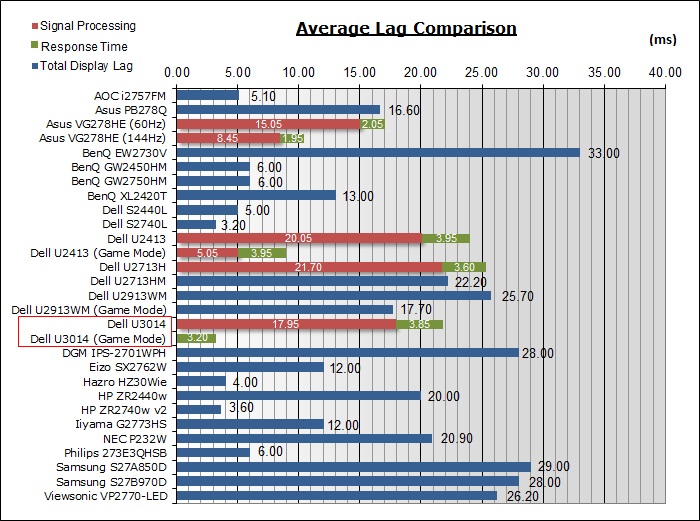
For the full reviews of the models compared here and the dates they were written
(and when screens were approximately released to the market), please see our
full
reviews index.
|
(Measurements in ms) |
Standard Mode |
Game Mode |
|
Total Display Lag (SMTT
2) |
21.8 |
3.2 |
|
Pixel Response Time
Element |
3.85 |
~3.2 |
|
Estimated Signal
Processing Lag |
17.95 |
~0.0 |
|
Lag Classification |
2 |
1 |
|

Class 1
(Game Mode) |
We have provided a comparison above against other models we have tested to give
an indication between screens. Those shown with blue bars represent the total
"display lag" as at the time of review we did not have access to an oscilloscope
system to measure the response time element and provide an estimation of the
signal processing. The screens tested more recently are split into two
measurements which are based on our overall display lag tests (using SMTT) and
half the average G2G response time, as measured by
the oscilloscope. The response time is split from the overall display lag and
shown on the graph as the green bar. From there, the signal processing (red bar)
can be provided as a good estimation.
The Dell U3014 showed an average total display
lag of 21.8ms during the initial tests in the standard preset mode. This lag was not too severe, but a bit higher than we
had seen from some other recent screens, and represented a lag of a little
under 1.5
frames. We measured half the average G2G response time as 3.85ms and so we can estimate
that the signal processing is approximately 17.95ms in this mode. When switching to the 'game'
preset mode we were very pleasantly surprised by the results. The screen goes
blank for about 1.5 seconds when you switch to this mode and it seems that a
pretty much all of the signal processing is removed, presumably through bypassing of
the internal electronics to a large degree. We measured an overall display lag
now of only 3.2ms, and so accounting for the response time element we can assume
that the signal processing is very low indeed, next to nothing (~0.0ms) which
was excellent. This game mode provides an overall lag which can be graded as CLASS 1 as
described above and should be fine for gamers.

Movies and Video

The following summarises the screens performance
in video applications:
-
30"
screen size makes it a reasonable option for an all-in-one multimedia screen,
but being quite a bit smaller than most modern LCD TV's of course. As far as
desktop monitors go it is at the very large end.
-
16:10
aspect ratio is less well suited to videos than a 16:9 format screen, leaving
larger borders on DVD's and wide screen content at the top and bottom.
-
2560 x
1600 resolution can support full 1080 HD resolution content easily
-
The
native screen resolution means that some source inputs (especially external
devices) will need to be scaled to fill the screen as many will be standard
1080 HD resolution (1920 x 1080).
-
Very
good range of hardware aspect ratio options which should be able to scale and
handle external devices easily. Nice to see an "auto" mode and 1:1 pixel
mapping included. The screen can handle 16:9 input aspect ratios well.
-
Digital interfaces support HDCP for any encrypted and protected content
-
Good to
see that both DVI and DisplayPort are provided on this model, allowing you to
connect your PC over DVI, and leave the DisplayPort free for an external
device potentially. Also good to see HDMI included as that is very popular and
widely used for external DVD and Blu-ray players.
-
DVI and
DisplayPort > Mini DisplayPort cables included in the box, but no "normal"
DisplayPort or HDMI cables included
-
Light
AG coating does not cause issues with reflections which glossy coatings can
-
Wide
brightness range adjustment possible from the display, including high maximum
luminance of ~355
cd/m2 and a good minimum luminance of
~45 cd/m2. This should afford you very good control for different
lighting conditions.
-
Black
depth and contrast ratio are good for an IPS panel at 882:1 after calibration.
Shadow detail in darker scenes should not be lost
-
Dynamic contrast ratio available and works to a reasonable degree. The static
contrast ratio is reduced in the 'movie' preset so if you want to use DCR we
would suggest using the 'game' preset mode instead.
-
'Movie' preset mode available but impacts static contrast ratio a lot so
should probably be avoided
-
Smart
Video Enhance Feature available from the OSD menu. This is a new feature we've
not seen on older Dell screens before. The feature automatically detects video
(motion) in any window on the screen, and applies enhancements to the video.
Only the video window is enhanced. Two different enhancement settings are
available as well, those being "Movie"- suitable for movie or multimedia video
clips, and "Advance" - User adjustable setting. This setting basically
features tweaked (or customisable in the case of the "advance" option)
settings for contrast, sharpness, offset, hue and saturation. It is designed
to only impact video content on the screen so may be a useful feature to some,
if you want to change the appearance of your video windows without impacting
on the overall screen appearance.
-
Wide
colour gamut available from the backlighting system, so those who prefer
brighter and more vivid colours for movies and videos can switch to the native
gamut mode and benefit. sRGB emulation also available if you prefer standard
gamut appearance.
-
Good
pixel responsiveness which should be able to handle fast moving scenes in
movies without issue. Potentially some overshoot artefacts in some transitions
due to aggressive overdrive impulse.
-
Wide viewing angles thanks to IPS panel
technology meaning several people could view the screen at once comfortable
and from a whole host of different angles. On darker content the IPS white
glow may present a bit of a problem if viewed from wider angles.
-
Good range of ergonomic adjustments available
from the stand. Should be easy to obtain a comfortable position for multiple
users or if you want to sit further away from the screen for movie viewing.
-
No
noticeable backlight leakage, and none from the edges which is good. This type
of leakage may prove an issue when watching movies where black borders are
present but it is not a problem here.
-
No
integrated stereo speakers on this model or audio connections but it is
compatible with Dell's SoundBar.
-
Picture in picture (PiP) and Picture By Picture (PbP) available if needed.
-
For
PAL sources, we have tested the screen and confirmed it will support
the full native resolution of 2560 x 1600 at 50Hz refresh rate.

Dell U3011 Comparison
I know
many people are going to be asking the question: "which is better, the old
U3011
or the newer U3014 model?" The U3011 is going end of life
now to be replaced by the U3014. We won't compare the various specs as they are
not really relevant in practice and I'll look instead at the performance
comparison based on our tests and some of the differences in features between
the two screens:


Dell U3011 vs. U3014 Comparison
|
|
U3011 |
U3014 |
|
Interfaces |
2x HDMI
2x DVI
1x DisplayPort
1x VGA
1x Component |
1x
HDMI
1x DVI
1x DisplayPort
1x Mini
DisplayPort |
|
Controls |
Touch sensitive |
Touch sensitive |
|
Features |
9-in-1
card reader
4x USB 2.0 hub |
9-in-1
card reader
4x USB version 3.0 hub |
|
Panel |
LG.Display
LM300WQ5 |
LG.Display
LM300WQ6-SLA1 |
|
Screen Coating |
Aggressive, heavy AG |
Light AG |
|
Panel Colour Depth |
10-bit
(possibly 8-bit+FRC?)
1.07 billion colours |
10-bit
1.07 billion colours |
|
Internal Processing |
12-bit |
12-bit processing
14-bit programmable LUT |
|
Hardware Calibration |
No |
Yes |
|
Backlight |
WCG-CCFL |
GB-LED |
|
Colour Space |
Wide gamut
(102% NTSC, 98% Adobe RGB) |
Wide gamut
(103% NTSC, 99% Adobe RGB) |
|
Emulation Modes |
sRGB and Adobe RGB |
sRGB and Adobe RGB |
|
Factory Calibration |
sRGB and Adobe RGB modes |
sRGB and Adobe RGB modes |
|
Design |
Squarer edges and thicker profile |
Slightly rounded edges and thinner profile |
|
Ergonomics |
Tilt, height, pivot |
Tilt, height, pivot |
|
Provided Accessories |
DVI, DisplayPort, D-sub cables and factory calibration report |
DVI and DisplayPort > Mini DisplayPort cables and factory calibration report |
Colour Space
With the
smaller 24" and 27" range Dell offer models which support for wide gamut colour
spaces (24" U2413 / U2410 and 27" U2713H / U2711) as well as models in the same
size which are more mainstream and feature a standard gamut backlight (U2412M
and U2713HM). This offers customers the choice of whether they want or need wide
gamut support and are willing to pay a premium for it, or if they are perfectly
happy with a standard gamut backlight system at a lower retail cost. The 30"
range is different as there is no standard gamut model available presumably
because this sector is seen as premium anyway and there is, at the moment, no
requirement for lower cost, standard gamut models. Instead manufacturers have
concentrated on the slightly smaller 27" market for those requirements.
Both the
old U3011 and new U3014 offer wide gamut backlights covering 102 - 103% of the
NTSC colour space. This can also cover the Adobe RGB reference space as a result
and extends considerably beyond the sRGB reference which is still widely used.
The support of wide gamut is great if you have a practical use for it and are
working with wide gamut content or want to match the Adobe RGB space properly.
However, if you are working just with sRGB content, viewing it on a wide gamut
screen can lead to issues of over-saturation and neon appearing colours and is
difficult to manage for many users. Thankfully both screens include an sRGB
emulation mode which is useful in those circumstances. The old U3011 used
WCG-CCFL backlighting to offer this colour space coverage, but the new U3014
uses the new GB-LED backlight system instead. This offers an ever so slightly
wider colour space (1% more of the NTSC reference). Really in practice there is
no difference in terms of the colour space coverage of both models, just the
backlighting technology used to obtain them. The GB-LED unit brings about some
energy and environmental benefits compared with the CCFL units.
Features and Specs
Again
not a massive amount has changed here. Dell have done away with the additional
DVI and HDMI ports on the U3014 as the U3011 had two of each. They have also
gotten rid of VGA (which can't support the full native resolution anyway) and
component (rarely used really for modern devices) and have instead added a Mini
DisplayPort which is probably more useful for modern needs. The U3014 still has
a decent set of connections but it might have been nice to keep the second HDMI
port perhaps. The new model does have some other new extras including support
for hardware level calibration (which the U3011 was lacking) and an upgrade to
the latest USB 3.0 standard for its 4 ports.
Performance
I've
included a table summarising these screens side by side based on the testing we
have carried out and on my opinions. The screens are colour marked as green
(winner) or red (loser) in each category which should be self explanatory. Where
I was not able to separate the two they are shown in grey. I will justify each
result below:

-
Features - The U3014 wins here as it's
added a few extras like USB 3.0 support, daisy chaining and hardware
calibration.
-
Screen coating - The new U3014 has a light AG coating and so does not suffer from a dirty, grainy appearance that the
heavy AG coating on the U3011 can bring.
-
Interfaces - The U3011 has a couple of
additional connections (1 more HDMI, 1 more DVI, VGA and component), but the
U3014 has Mini DisplayPort and Daisy Chaining support which are probably more
useful to modern users. We've marked them level as it really depends what you
need.
-
sRGB colour support - The U3014 has a
slightly more accurate sRGB coverage from its emulation mode. The additional
flexibility to hardware calibrate the screen to more accurately cover sRGB
also puts it ahead of the U3011 which did not support hardware calibration.
-
Office and Windows - There's not a
massive amount to separate them on here although I've marked the
U3014
as more suitable
thanks to the lighter AG coating. The addition of USB 3.0 is also useful and
helps put the new
U3014
ahead of the old U3011 a little.
-
Viewing angles - No real separation
here
-
Movies Overall - The U3011 might
have a couple of extra connections which may be useful but the U3014 has a
better contrast ratio and workable DCR which we feel are probably more
important to most.
-
Responsiveness - Not a massive
amount to separate them all here really. They all behaved quite similarly in
practice with low levels of motion blur and good pixel response times. The
U3011 had less overshoot though so we have marked that ahead of the U3014.
-
lag - hard to accurately
compare since the U3011 was only tested using the old stopwatch method. We've
provided the figure for reference but keep in mind the
U3014
figures are far more
accurate than the old U3011 measurement. The
U3014
does feature a useful 'game' mode which
greatly reduces the lag so puts it ahead of the U3011 because of it.
-
Black depth - We achieved the best result
with the U3014 after calibration (0.14). The U3011 (0.16) was a little behind.
-
Calibrated Static Contrast Ratio -
Again the
U3014 has the edge with a higher contrast ratio
of 882:1 (after hardware calibration at the screens native gamut) than the
older U3011 (727:1).
-
Dynamic Contrast Ratio - The feature
worked quite well on the U3014 surprisingly with 3118:1 achieved in the game
preset mode. This feature didn't seem to work at all on the U3011 really.
As we'd
concluded with the 27" U2713H and 24" U2413 models as well, overall
the U3014 felt like a worthy successor to the popular U3011. There's been some
positive changes made including a much lighter AG coating, hardware calibration support, USB 3.0 inclusion, an improved black
depth and improved contrast ratio. Thankfully Dell
have not cut corners and have kept some of the premium features from the old
model as well with touch sensitive buttons, a wide colour gamut backlight,
10-bit colour depth and even the integrated card reader. Dell may have done away
with a couple of things like the composite, D-sub and additional HDMI and DVI connections but
in today's market they're not really missed and are easily out-weighed by the
new things they've added instead. The replacement of the U3011 is certainly
justified we think. Of course this is still aimed more at professional users and
so carries a higher price point than some of the more mainstream models out
there in the slightly smaller 27" market, but the extra features justify that
price point well, and to be fair it's very competitively priced.

Conclusion
The Dell U3014 felt very much like a larger
version of the U2413 and U2713H models. All 3 are very similar overall which
isn't a bad thing. Like its smaller brothers the U3014 includes a great set of
features, connections and extras. The update to a much better light AG coating,
the inclusion of USB 3.0 and particularly the addition of hardware calibration
is great to see and all welcome changes since the old U3011 model. It was also
pleasing to see Dell have kept some of the premium features like the card reader
and adjustable stand. The switch to a GB-LED backlight system from wide gamut
CCFL brings about energy and environmental benefits and its been proved they can
certainly compete with the older CCFL units in terms of colour space coverage
and picture quality. Some of the new features missed the mark a little sadly,
particularly the uniformity compensation feature which was useless in practice.
The hardware calibration was also quite limited in software features and device
support as we've concluded with the 24" and 27" models but maybe there's room
there for Dell and X-rite to improve it in future software updates.
Default setup of the screen was good really, even
in the standard mode and the monitors full native gamut. The factory calibrated
Adobe RGB and sRGB modes were also pretty good although we would have liked to
have seen a slightly better gamma curve and a slightly better emulation of the
target colour space, particularly in the Adobe RGB preset which seemed to stray
from the required coverage a bit too much. Thankfully the hardware calibration
did a great job of setting the screen up, improving the calibrated contrast
ratio (compared with software calibration methods) and even correcting some of
those colour space coverage issues nicely. The use of PWM for backlight dimming
may put some people off initially, but it was good to see this was operating at
a very high frequency and so shouldn't preset much of a problem to most users.
Like the smaller versions the U3014 offered decent
response times but did exhibit some nasty overshoot problems in certain
transitions. This was probably the main weakness of the screen we felt, and a
shame Dell have not set up the overdrive impulse a little better or provided the
user with the option to change its level through the OSD menu. Keep in mind of
course that the screen isn't really aimed at gamers and so for the intended
audience it shouldn't really be a big problem. It can still handle gaming pretty
well if required. In fact we were very pleased with the lag of the display when
switching to the game mode which seemed to eliminate pretty much all of the
signal processing lag it seemed.
We've already concluded in the previous section
that we feel the U3014 is a worthy successor to the U3011. There isn't a massive
amount of choice in the 30" market at the moment but we'd expect some new models
to emerge from the likes of HP, NEC and Eizo at some point, probably using the
same panel as the U3014 and offering a similar feature set. If you're looking
for a 30" sized screen then the U3014 is a very good choice and we would expect
it to certainly remain one of the more competitively priced models in this
sector.
|
Pros |
Cons |
|
Positive improvements from old
U3011 - lighter AG coating, hardware calibration, USB 3.0 |
Pixel response times show some
bad overshoot in certain transitions |
|
Hardware calibration produces
good results including accurate colour space emulation |
PWM used for backlight
dimming. May affect very sensitive users but 2500Hz frequency unlikely to
be problematic for most. |
|
Game preset mode greatly
improves lag |
Uniformity compensation
feature useless in reality |
|
 |
If you have enjoyed
this review and found it useful, please consider making a
small
donation to the site. |
